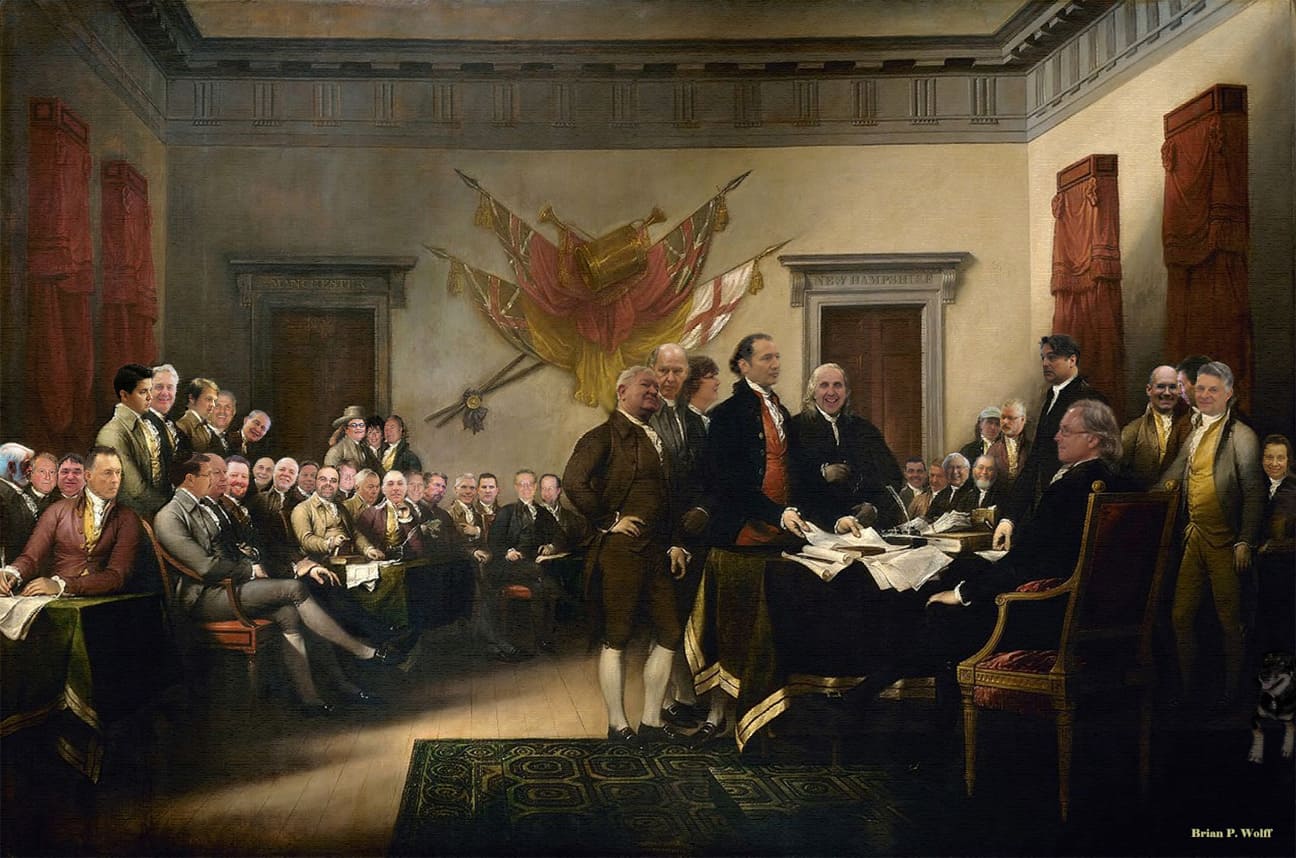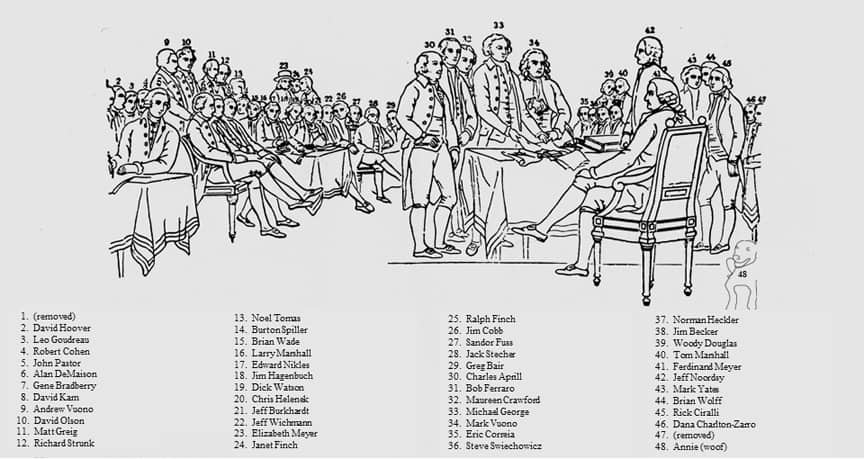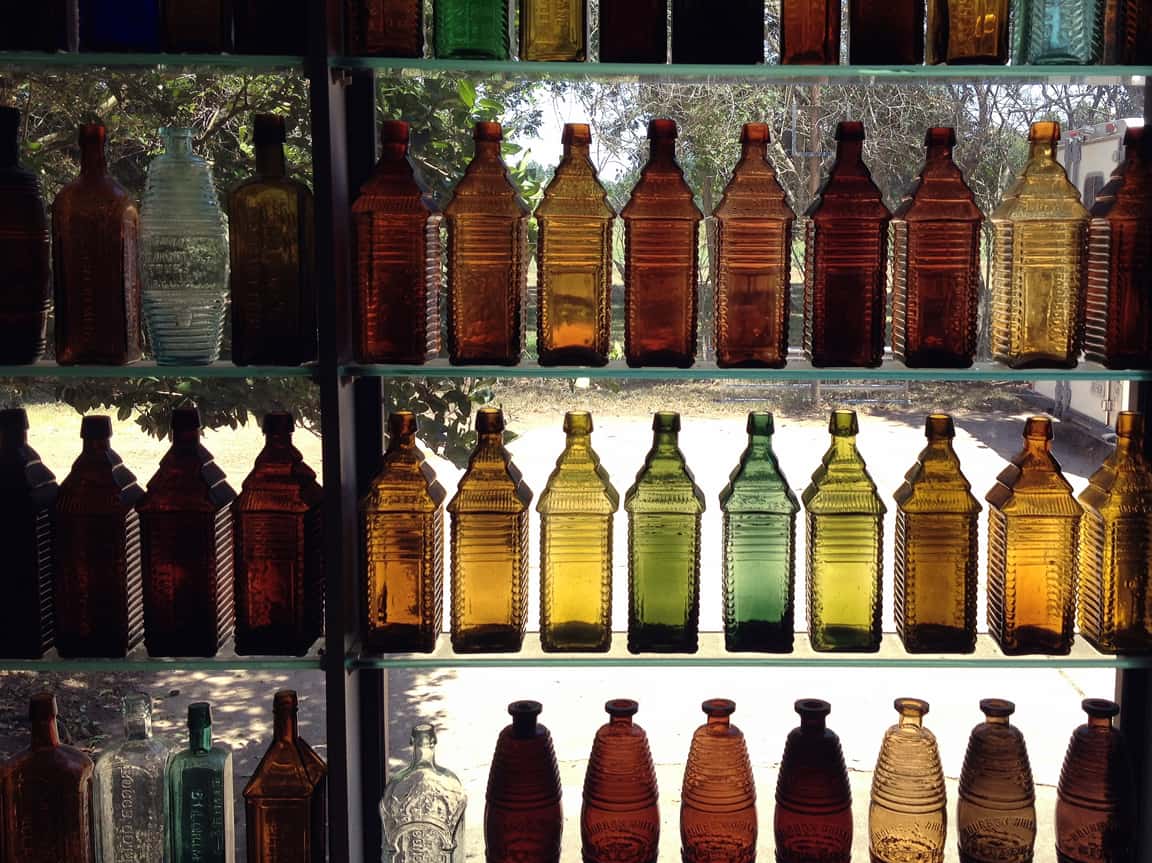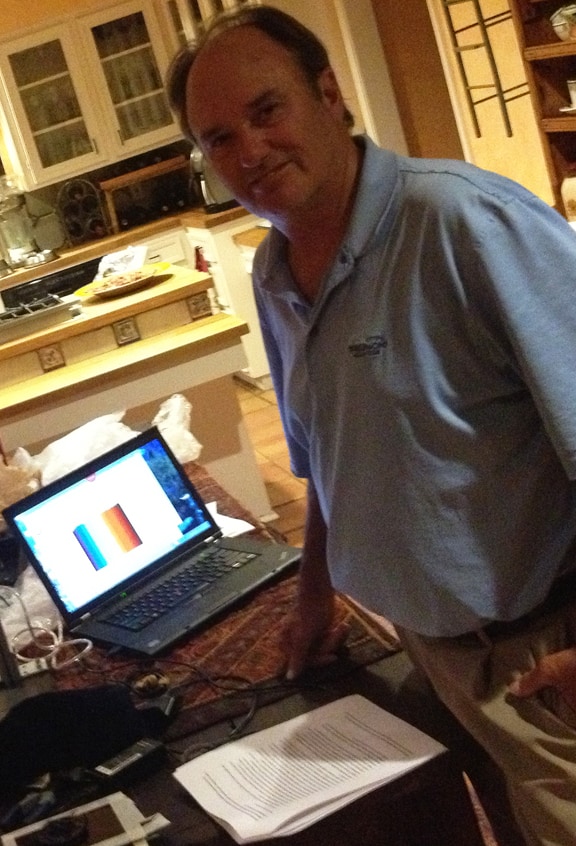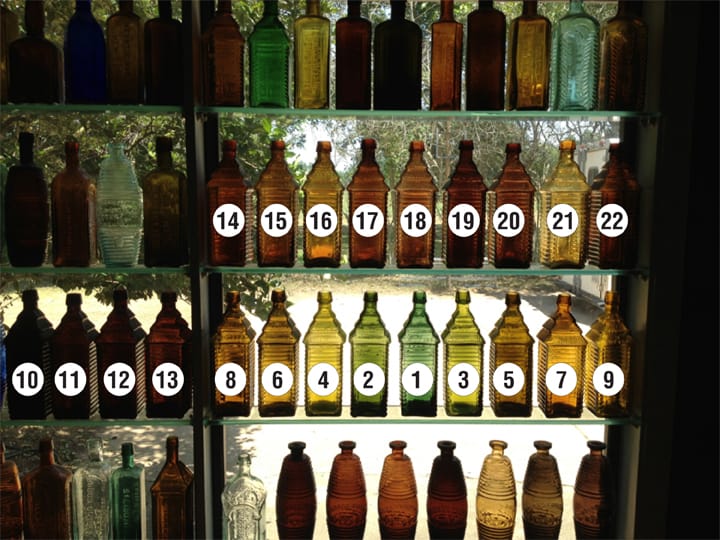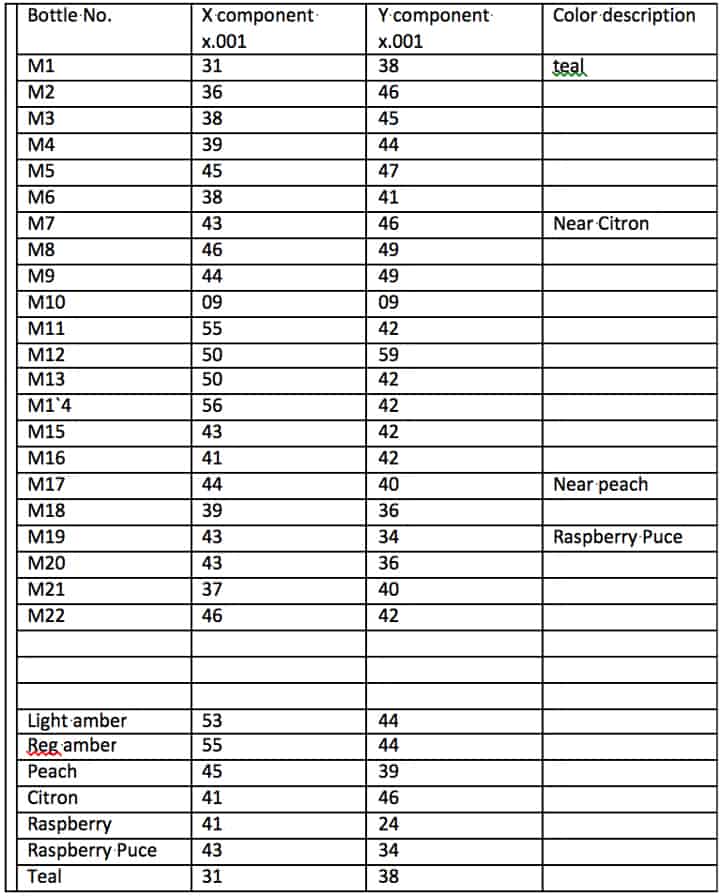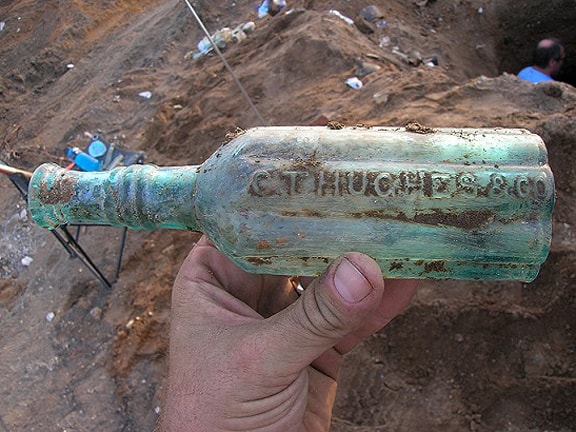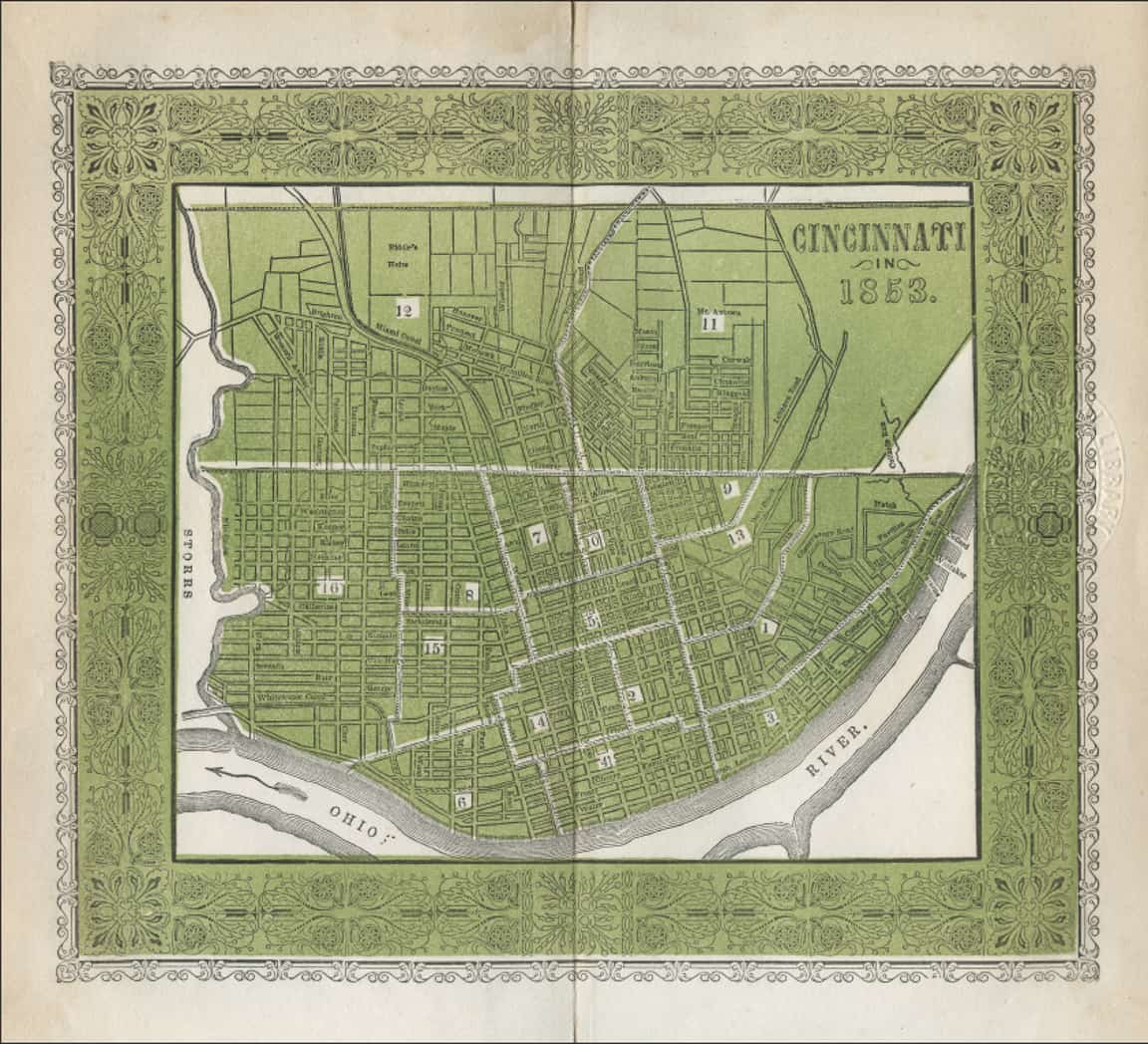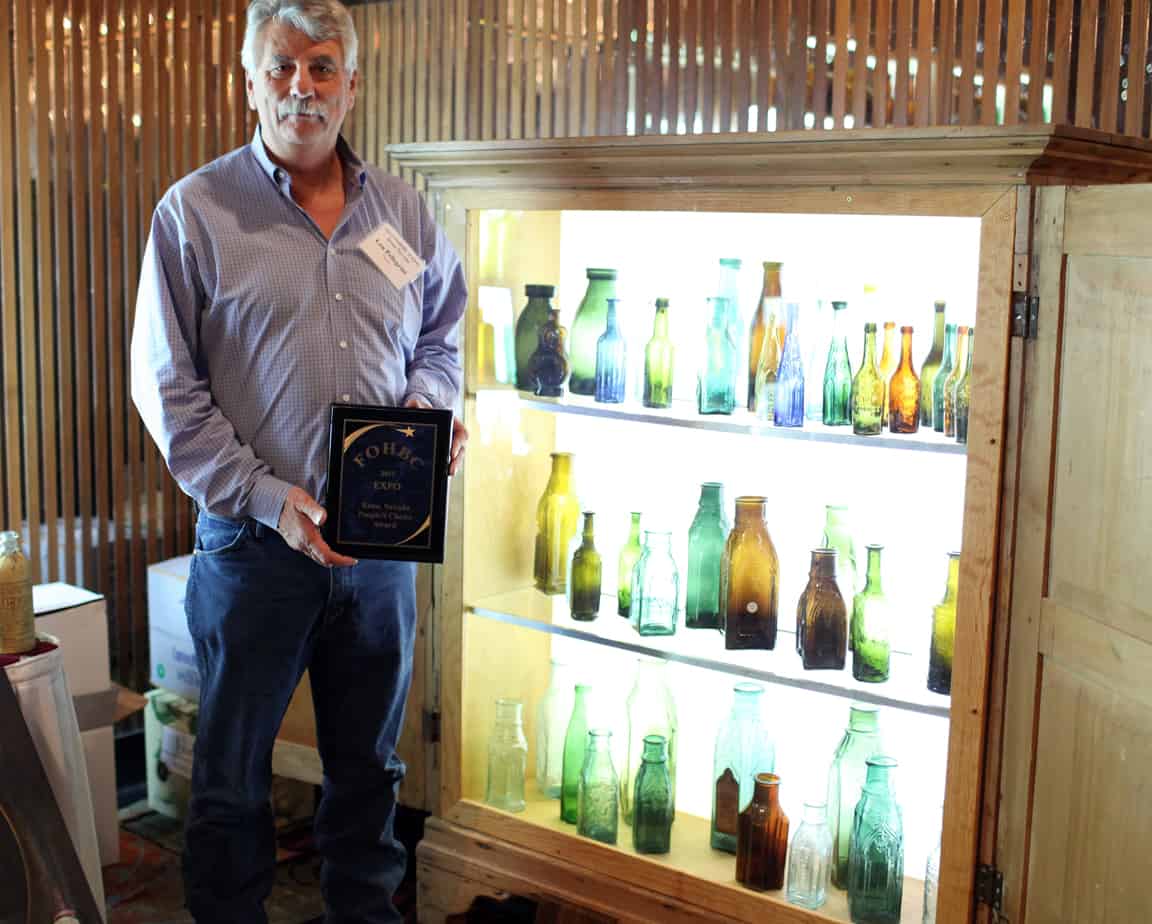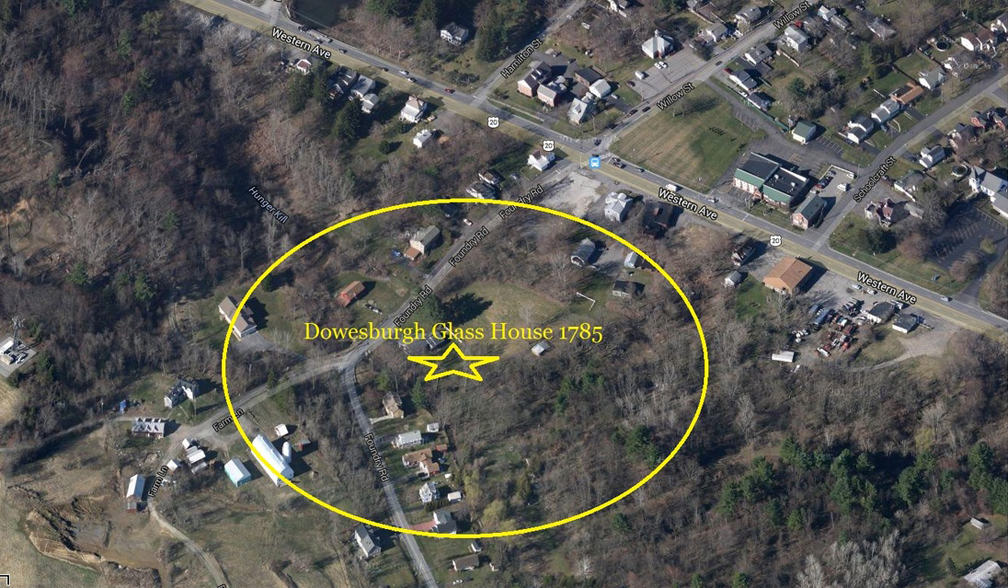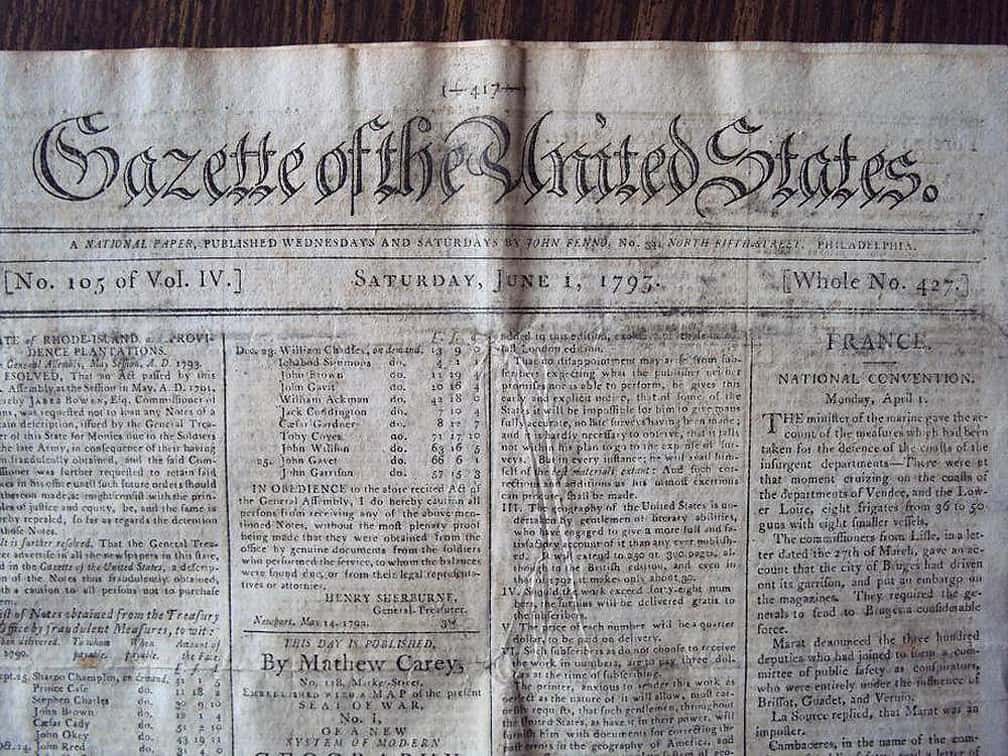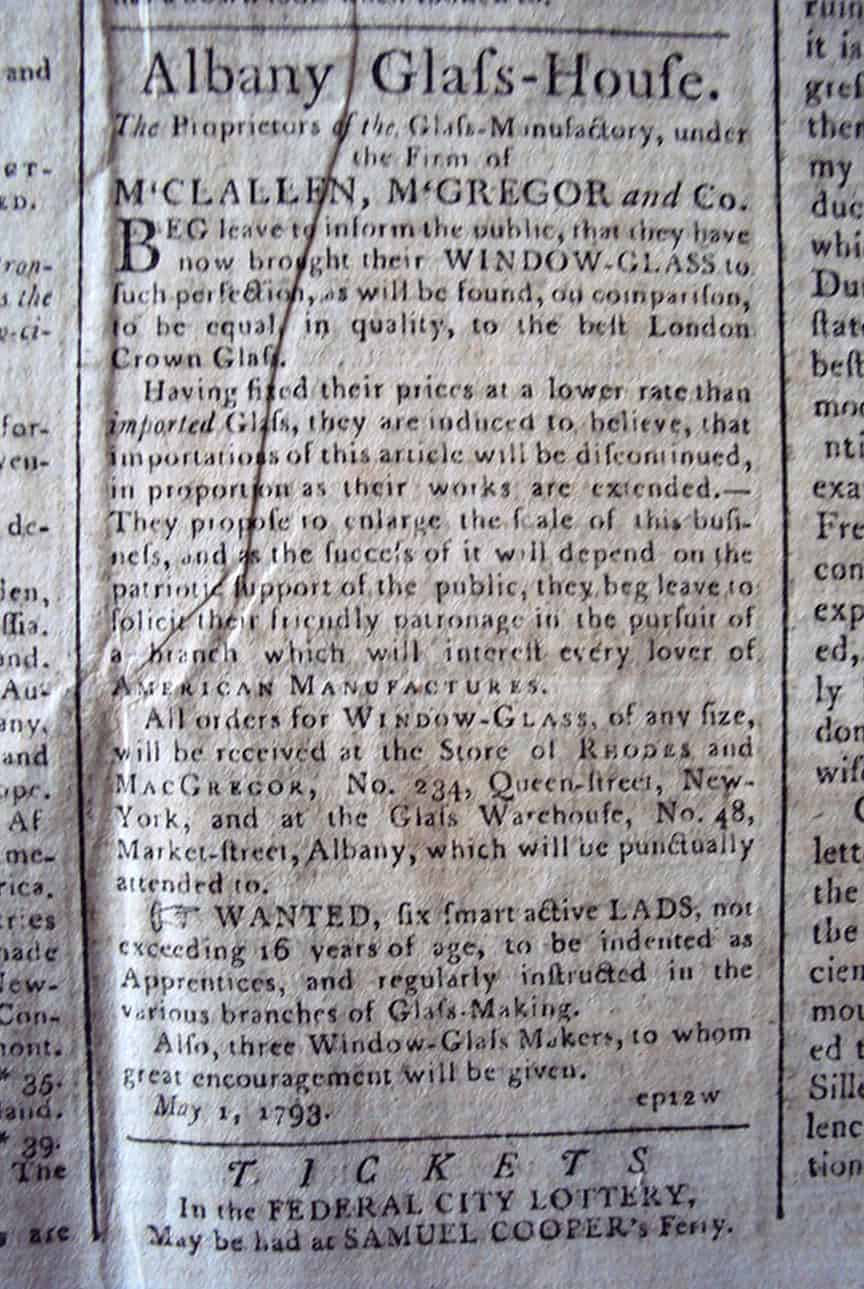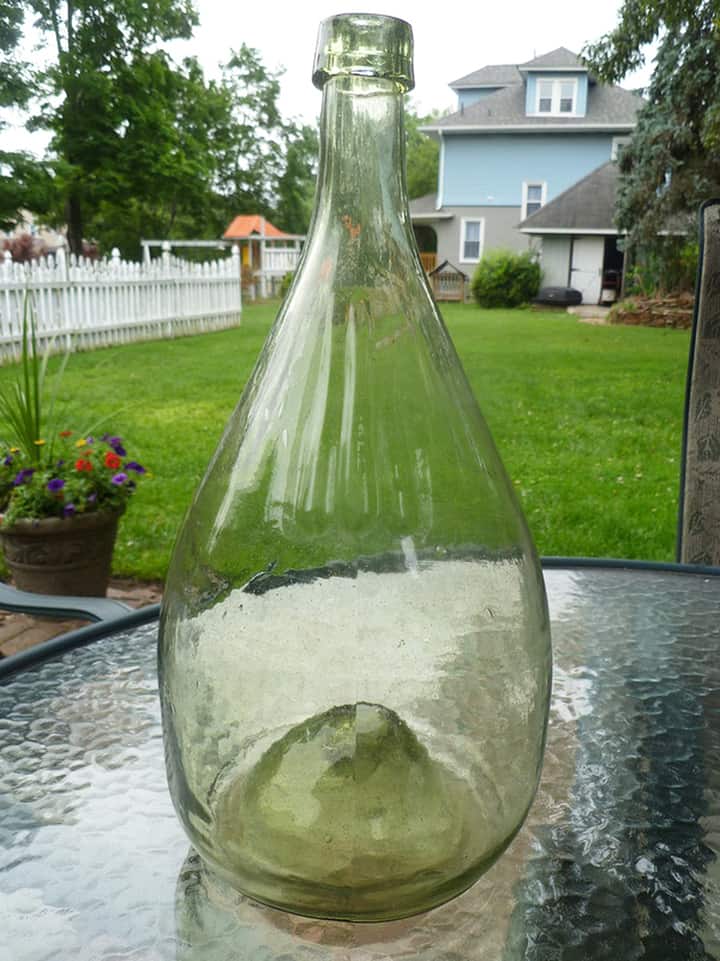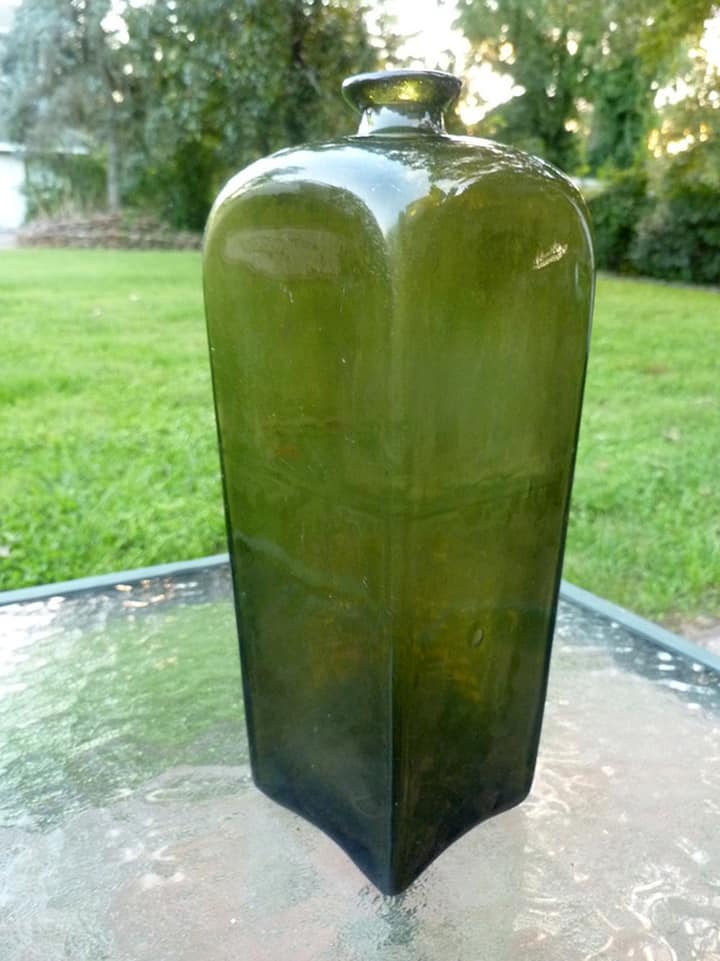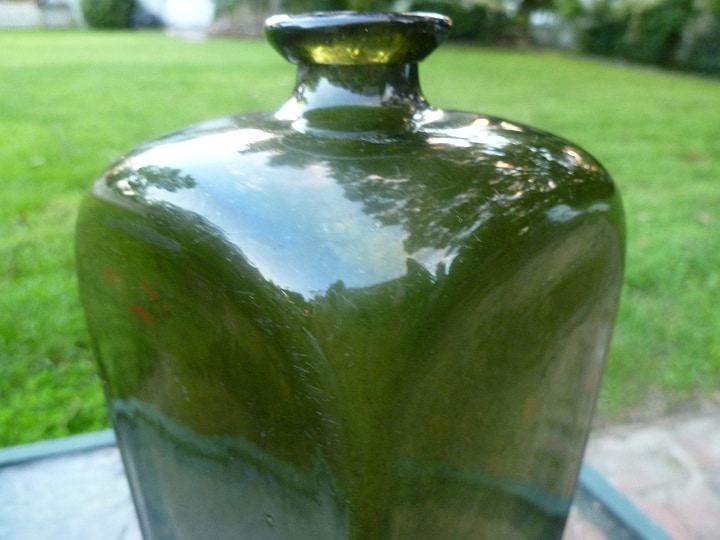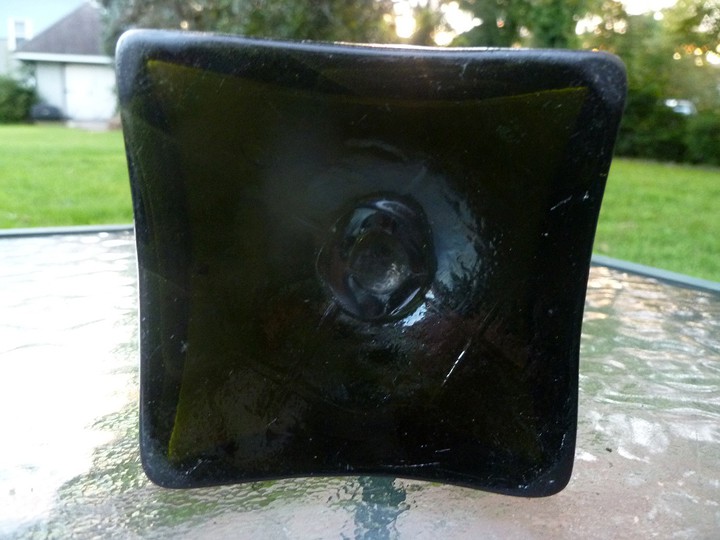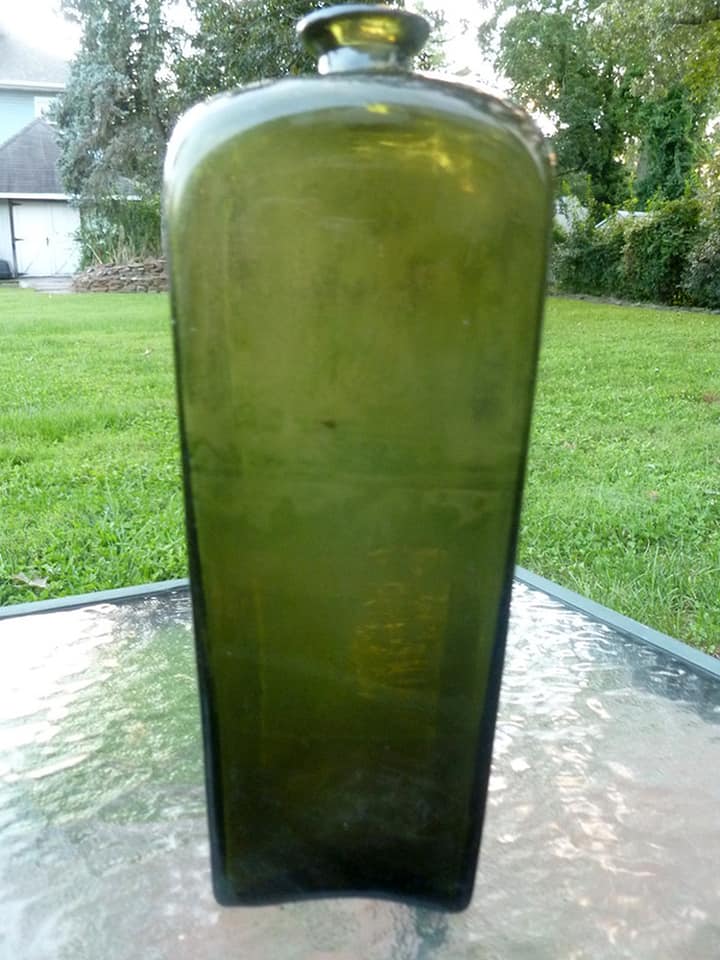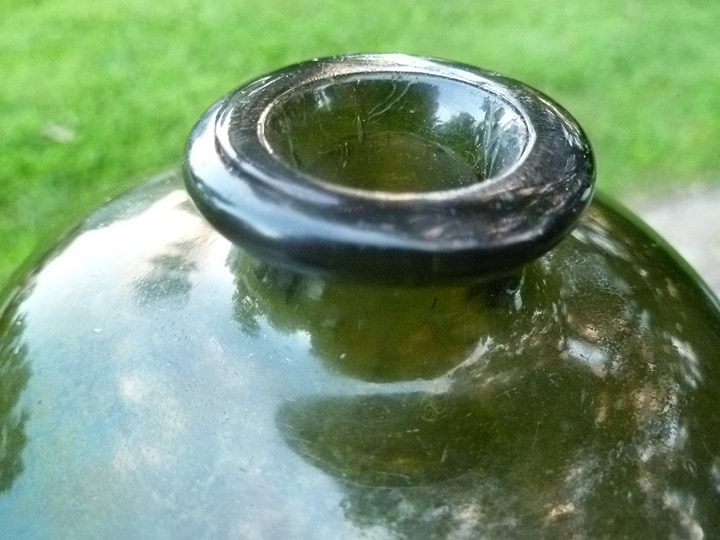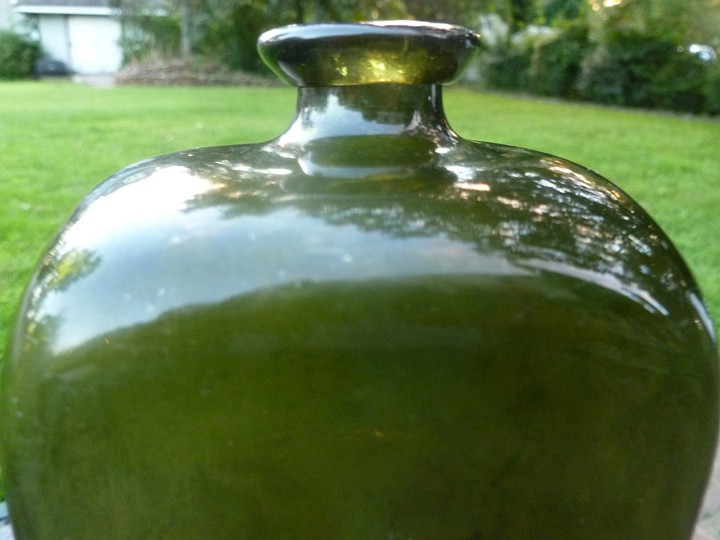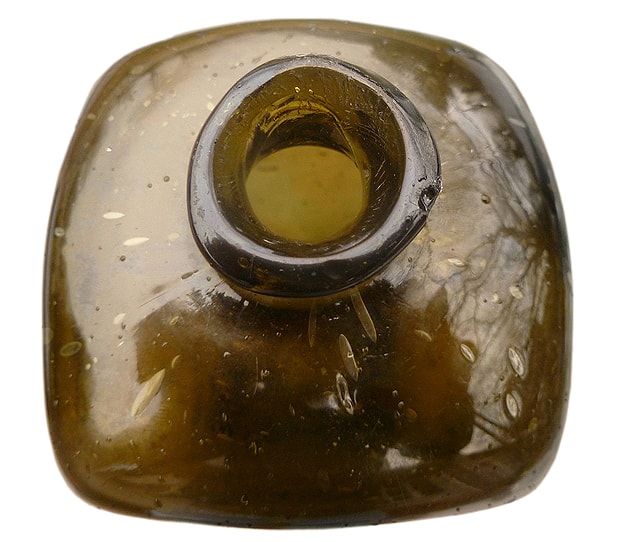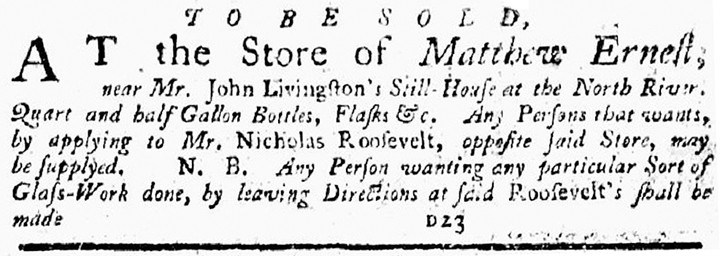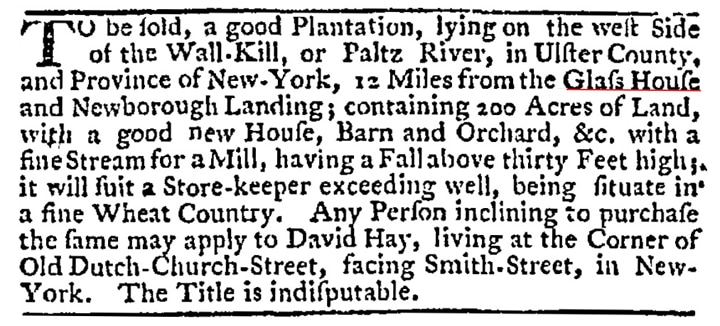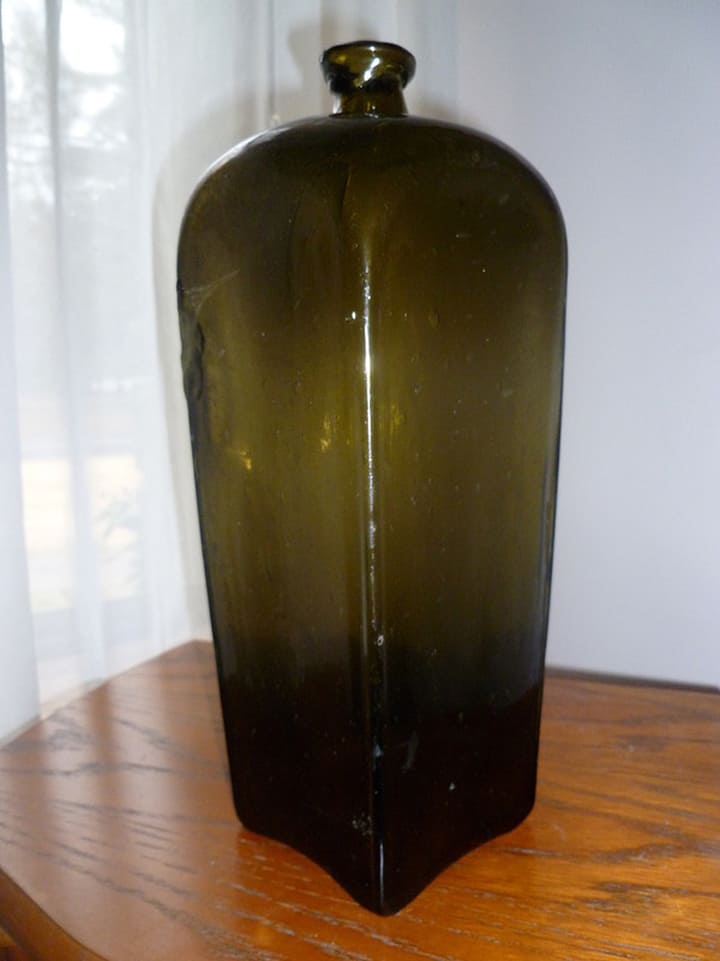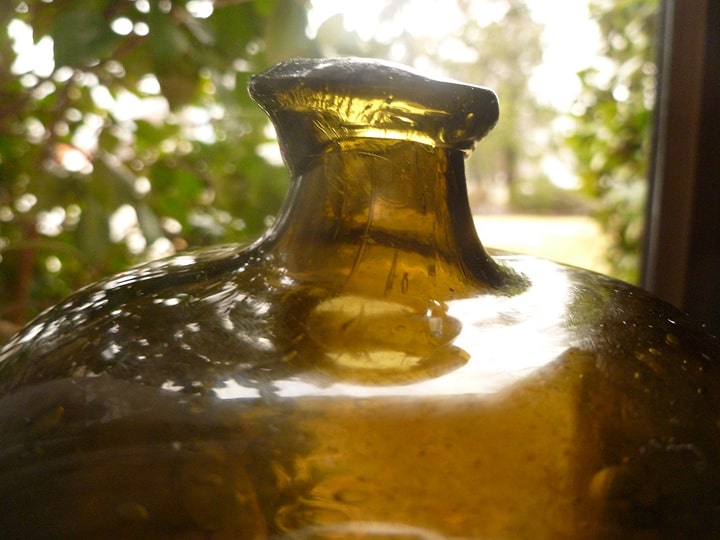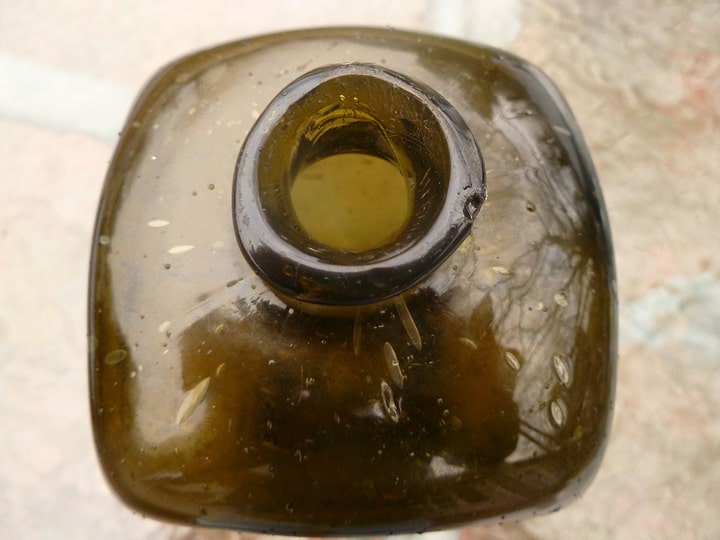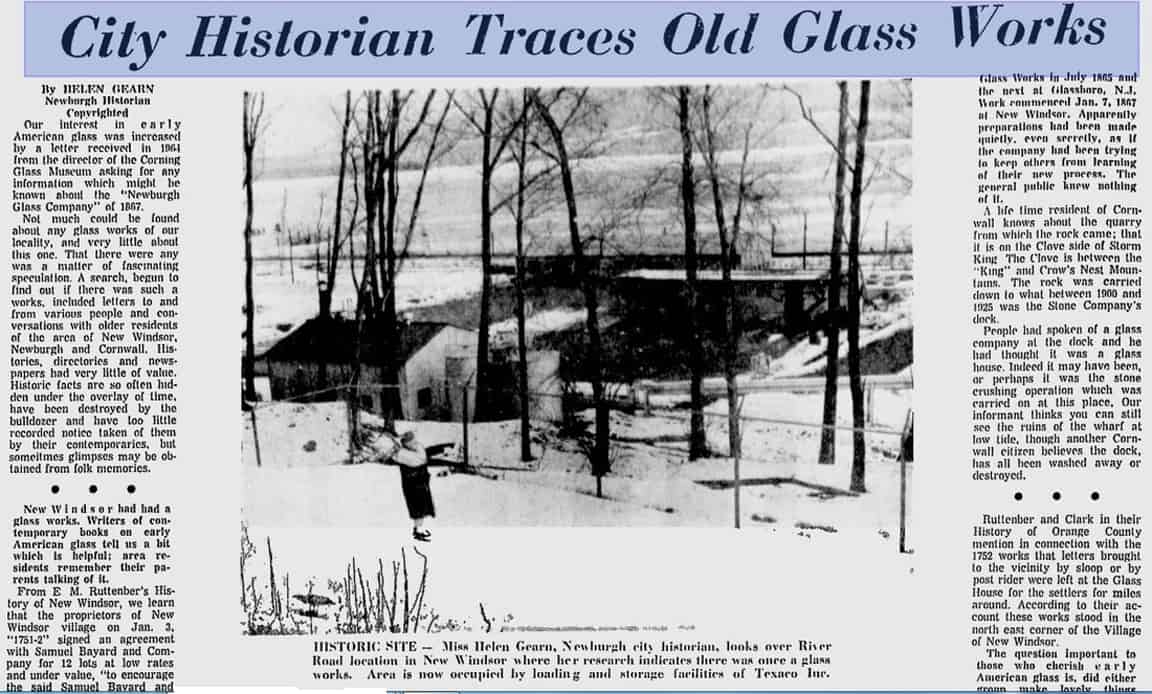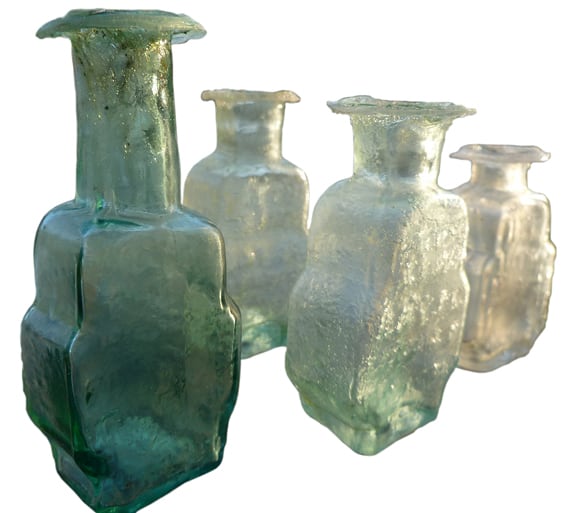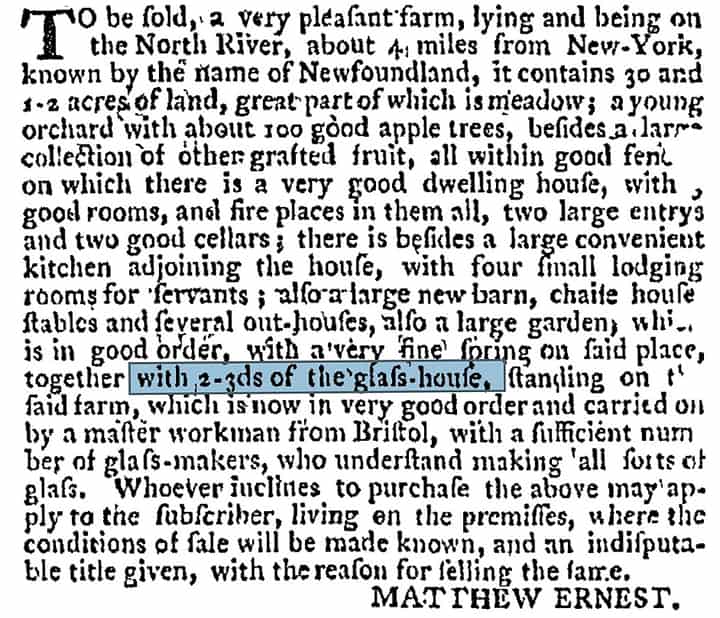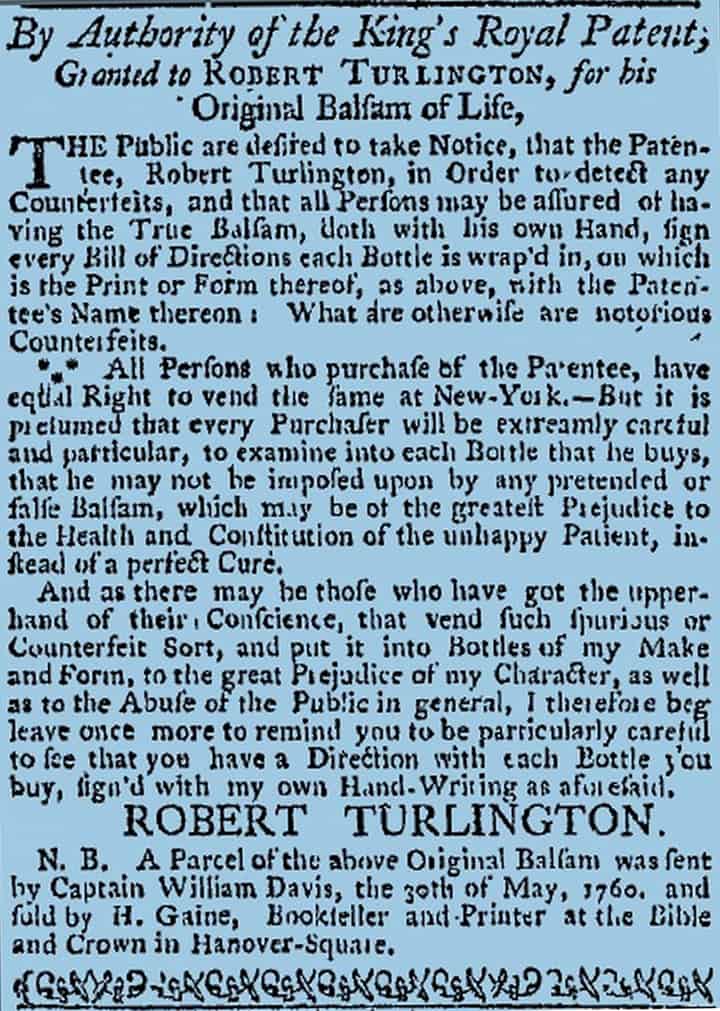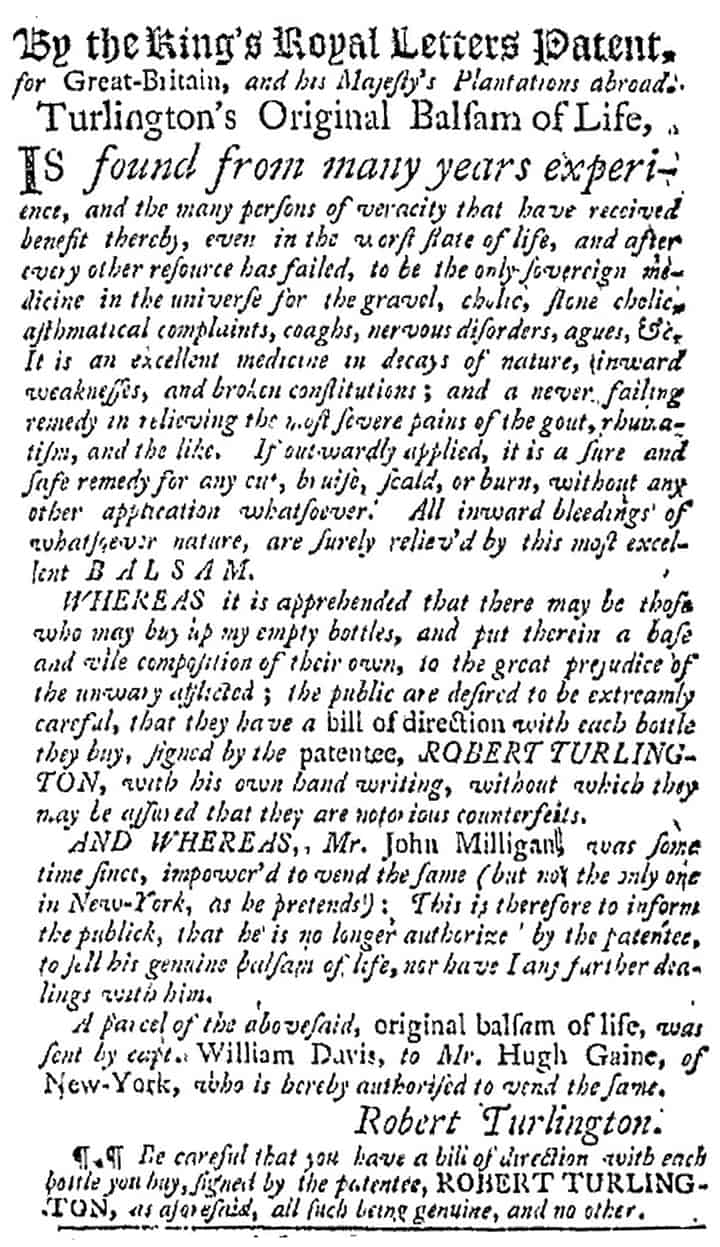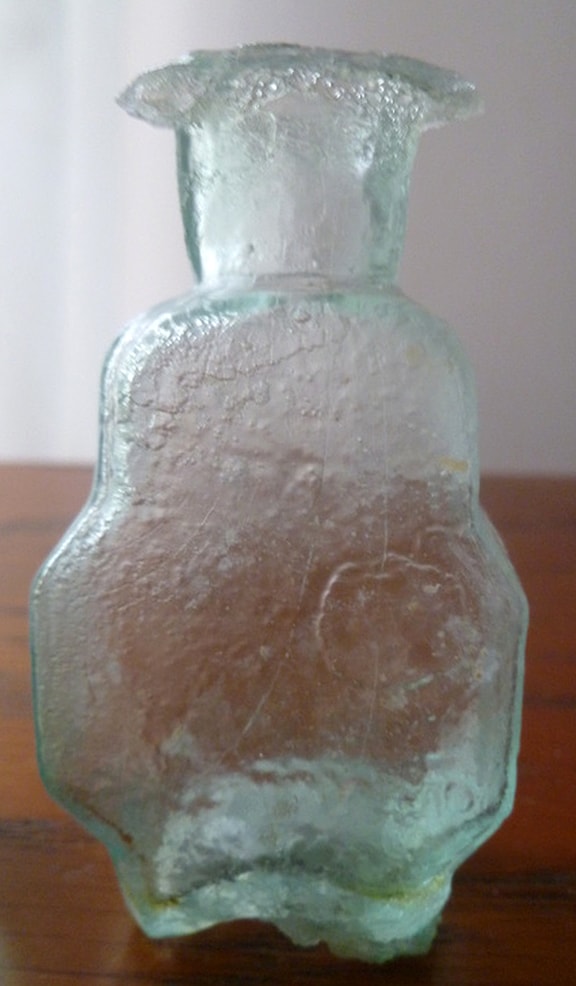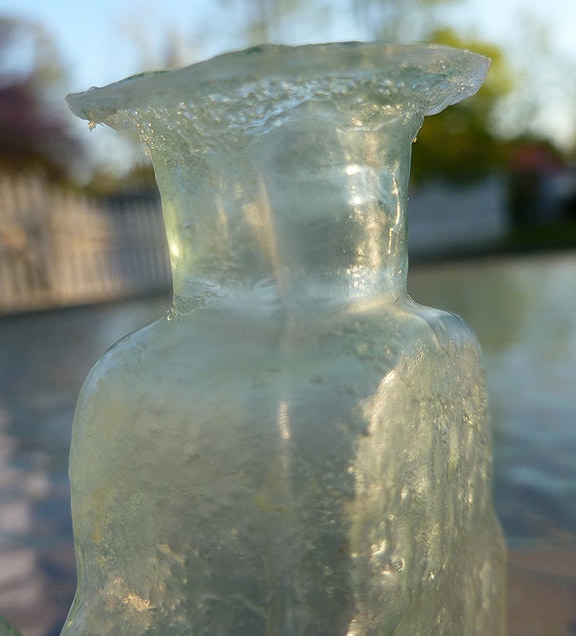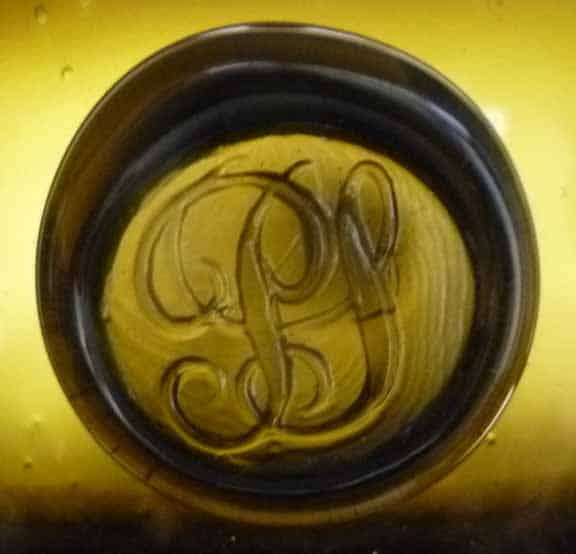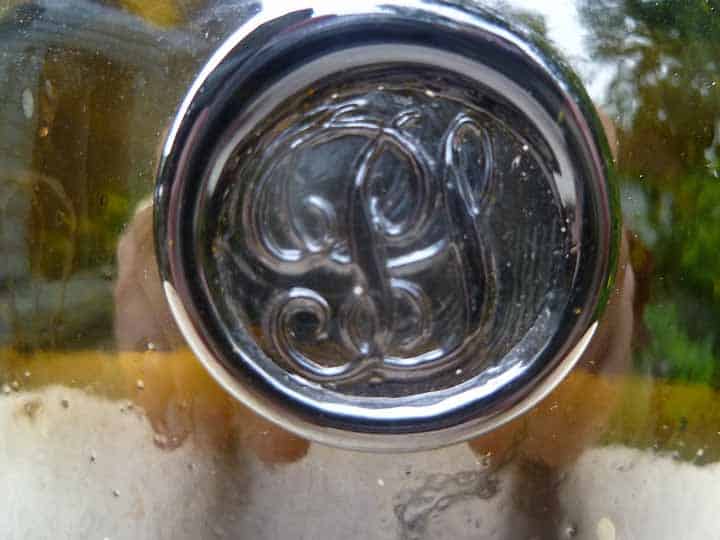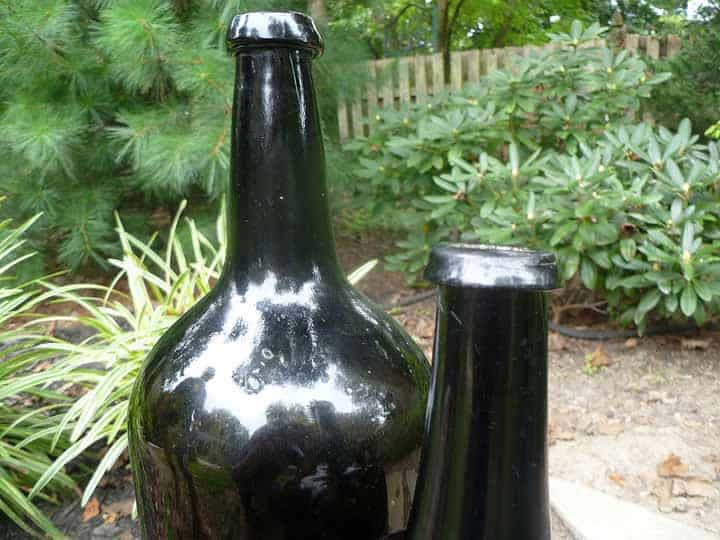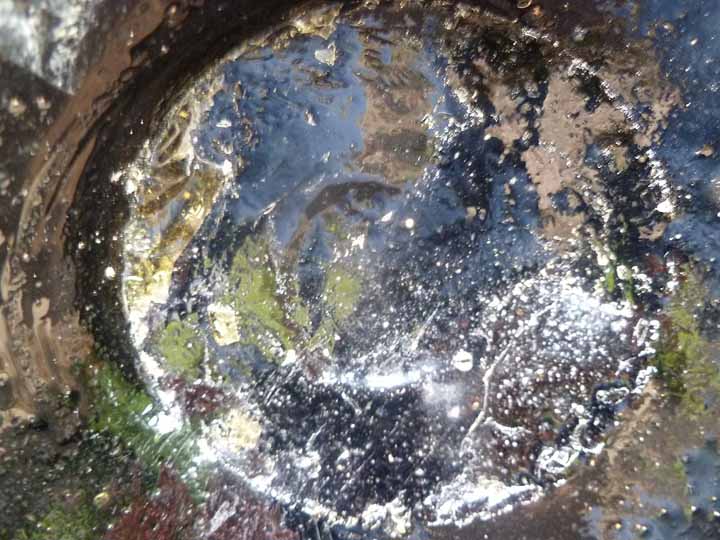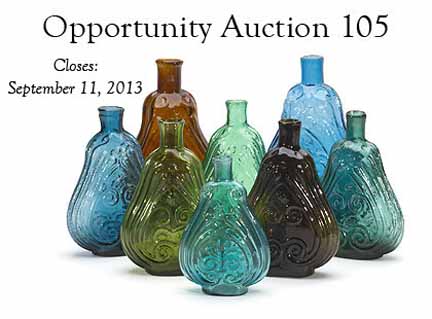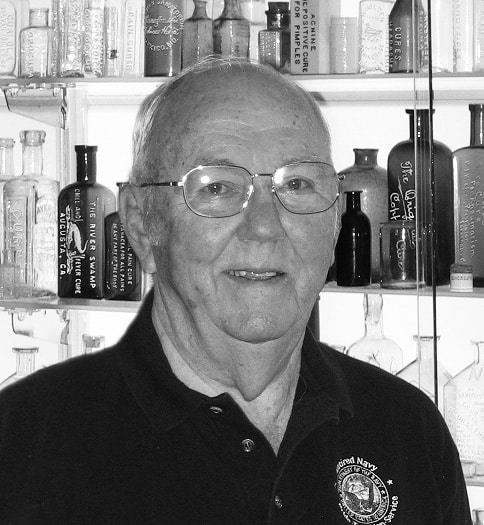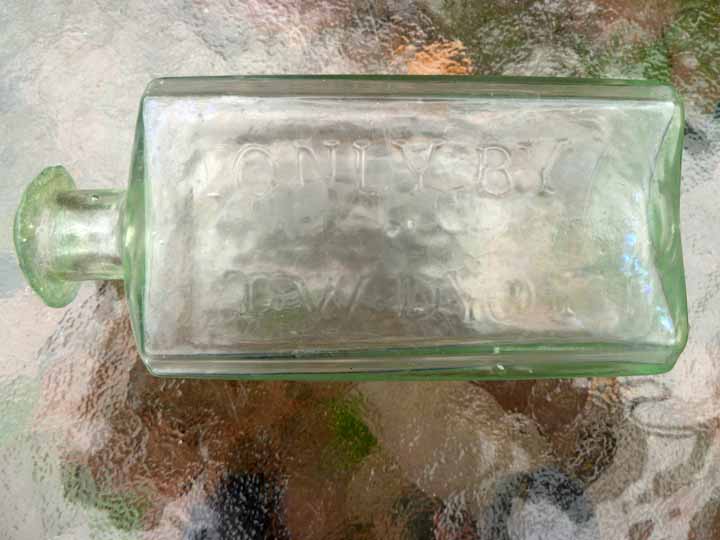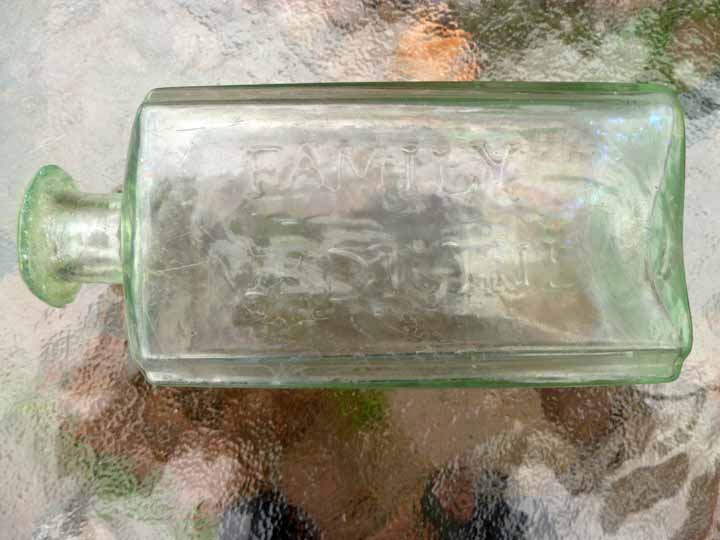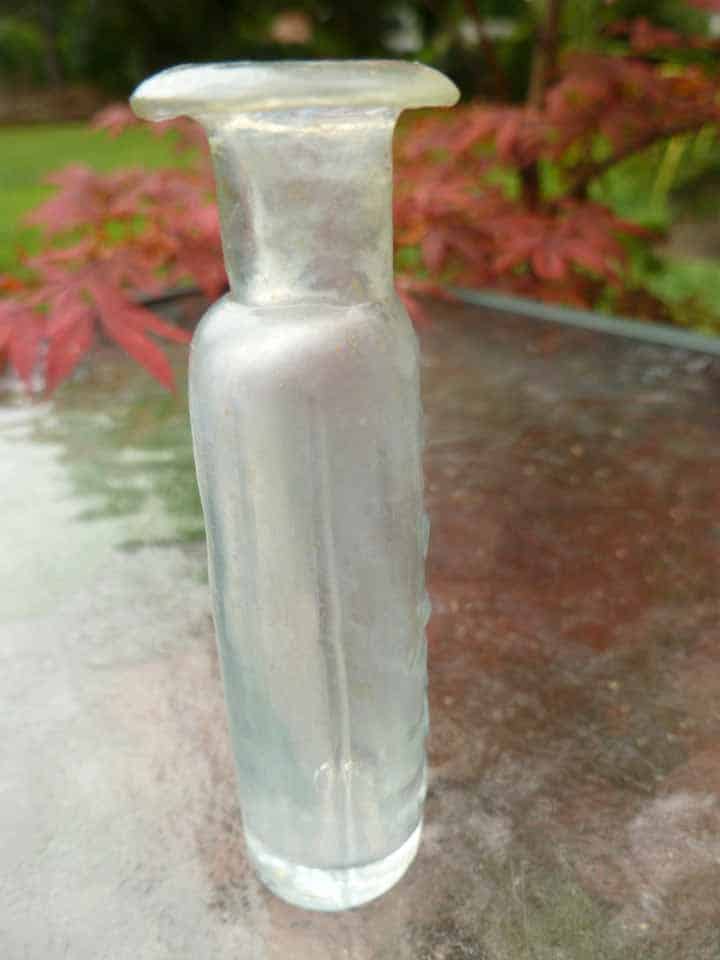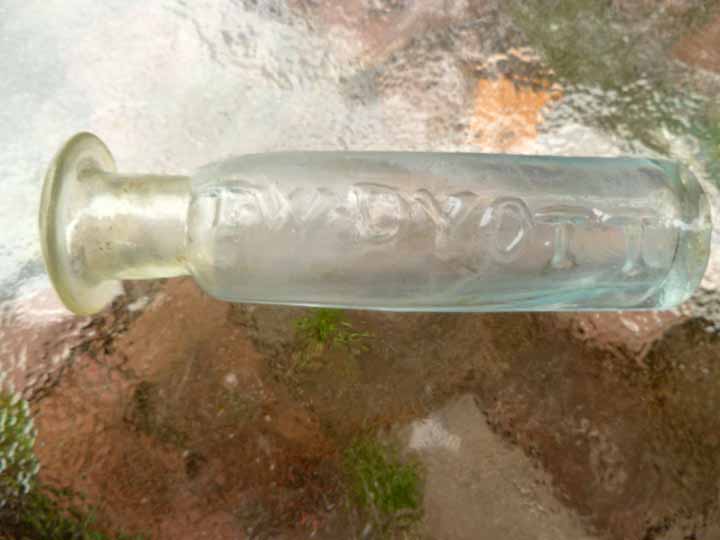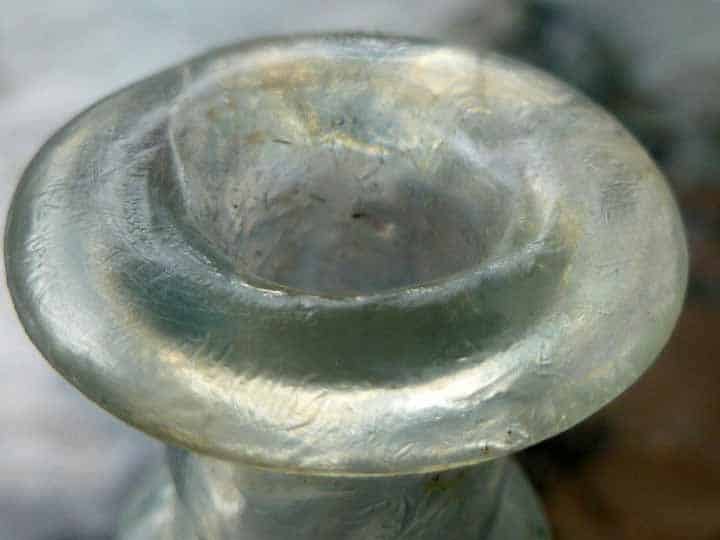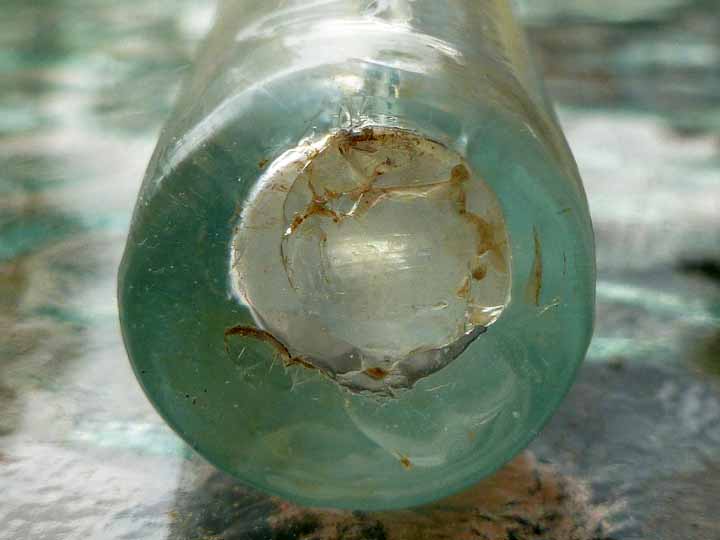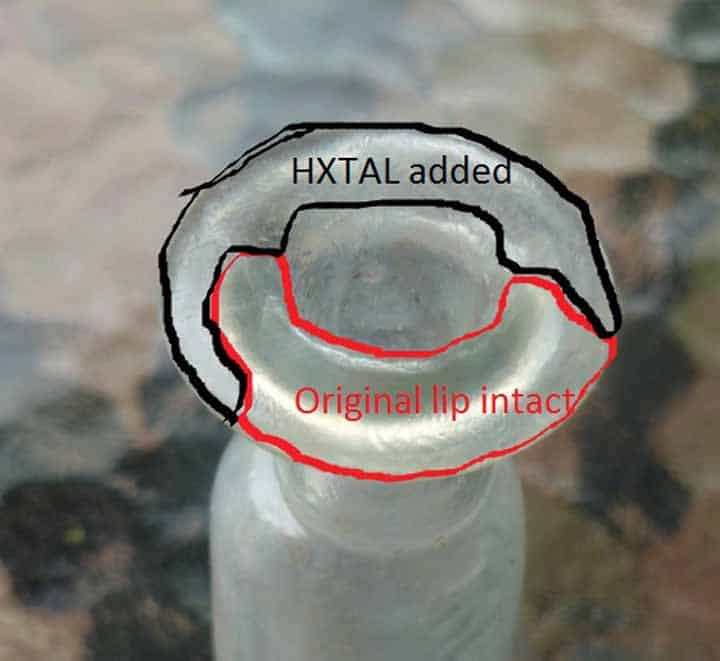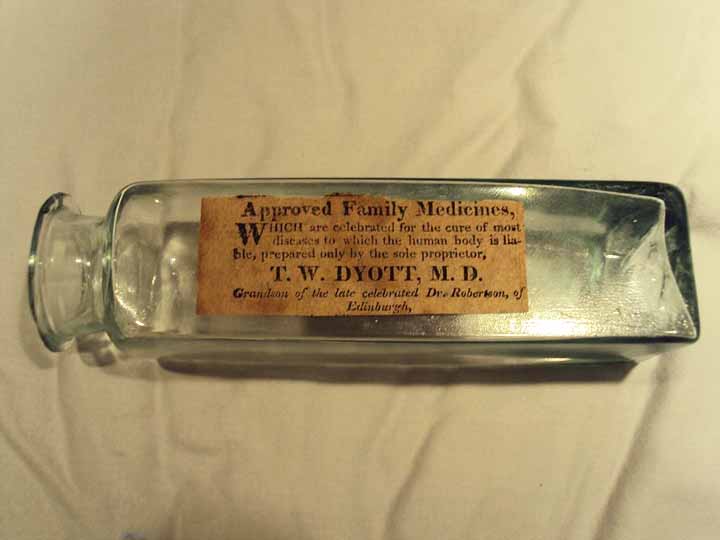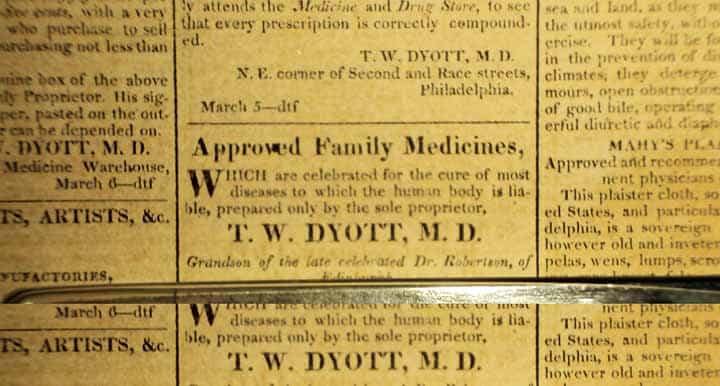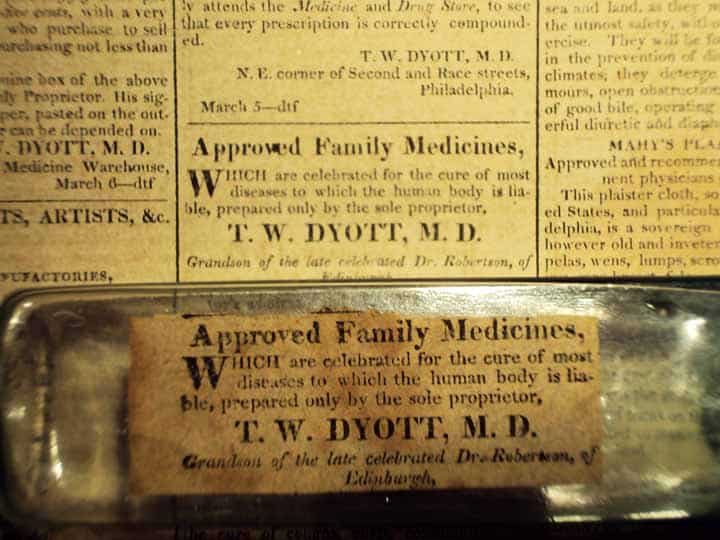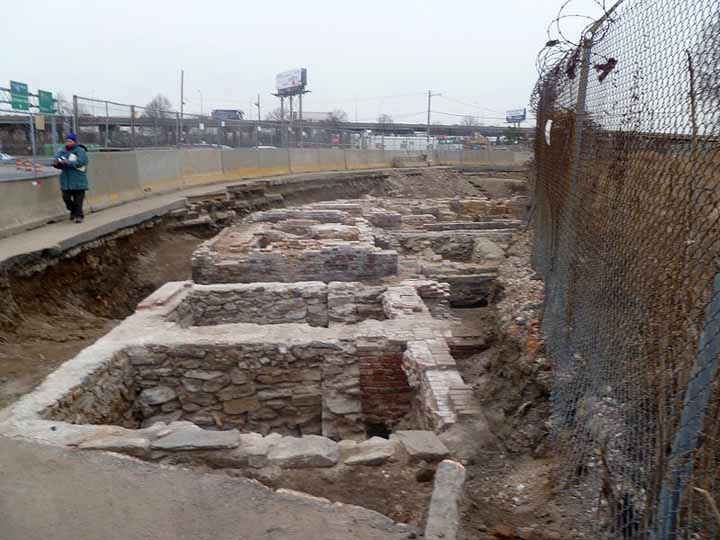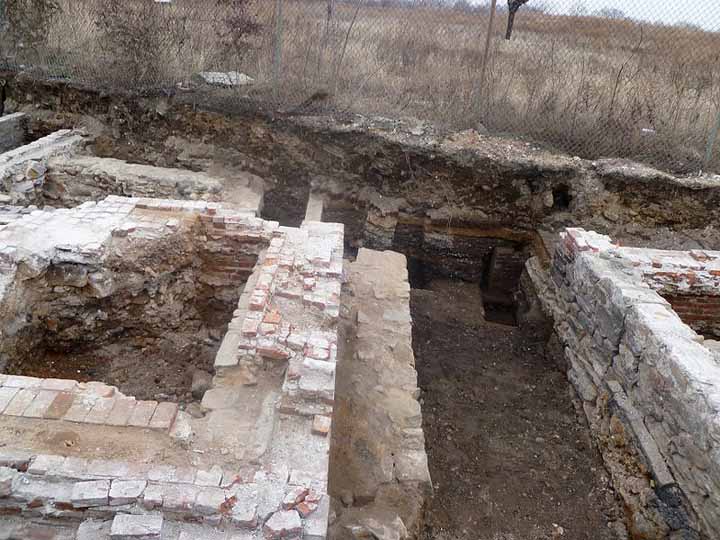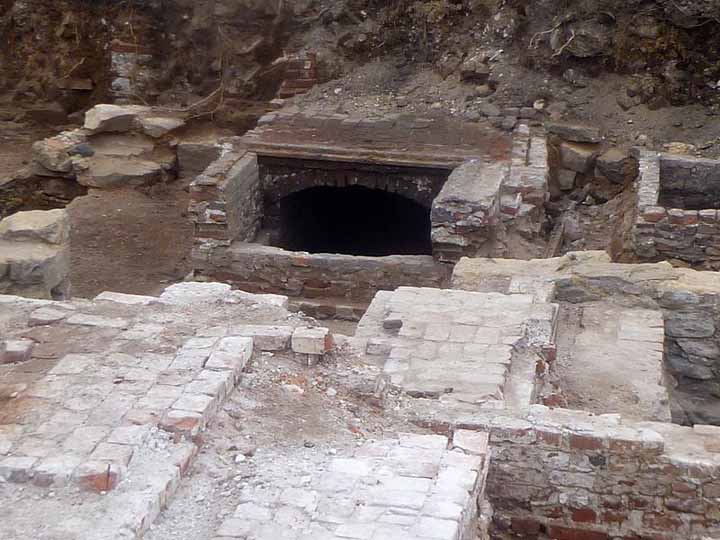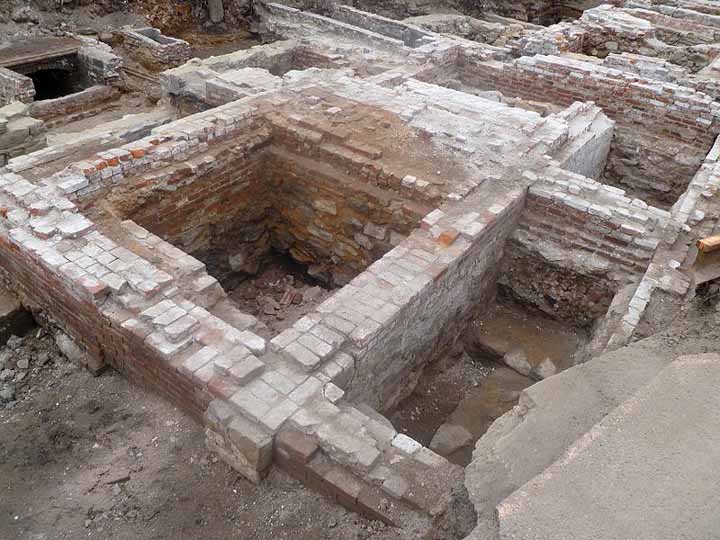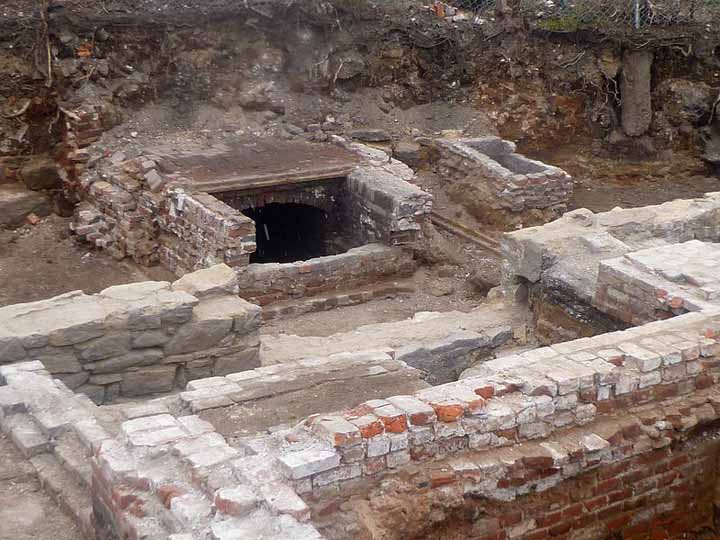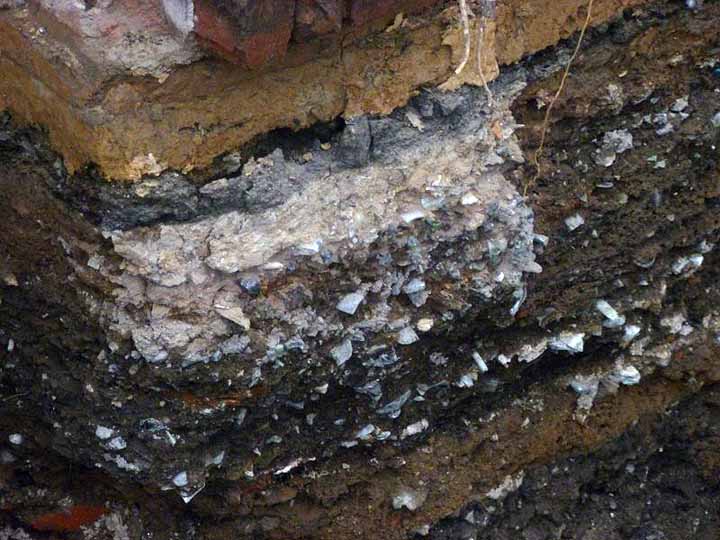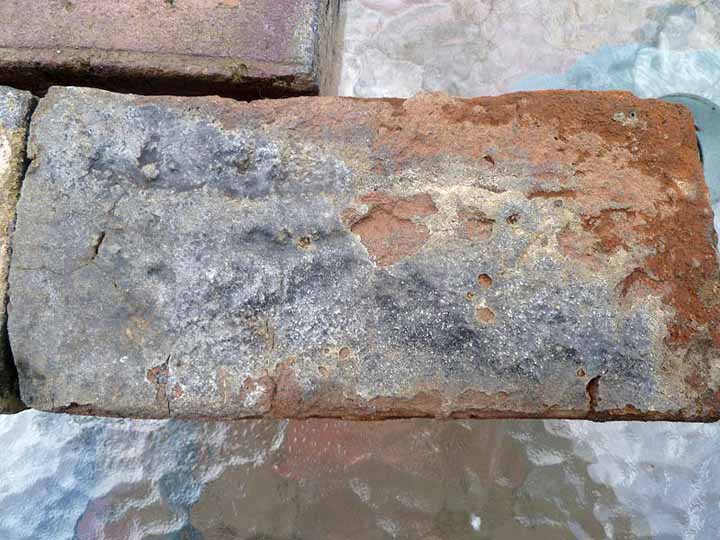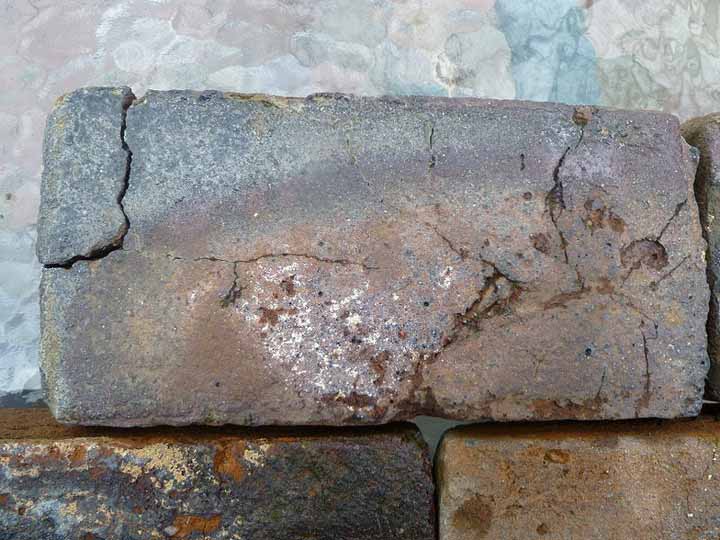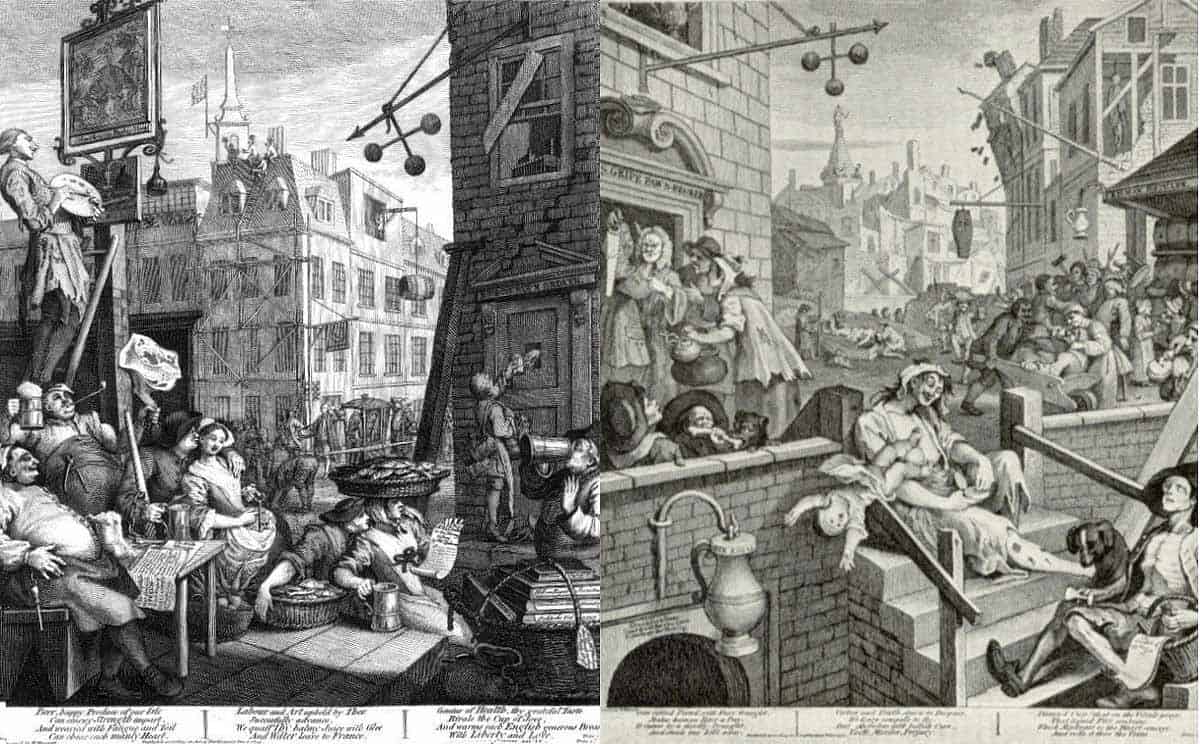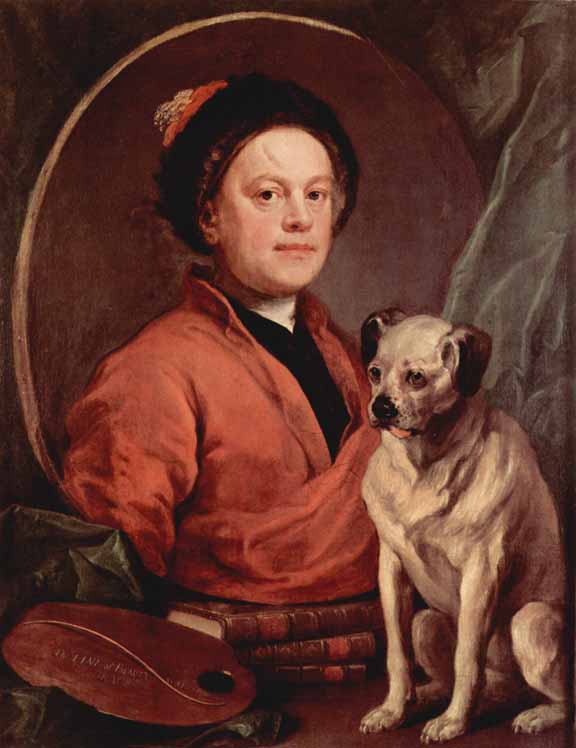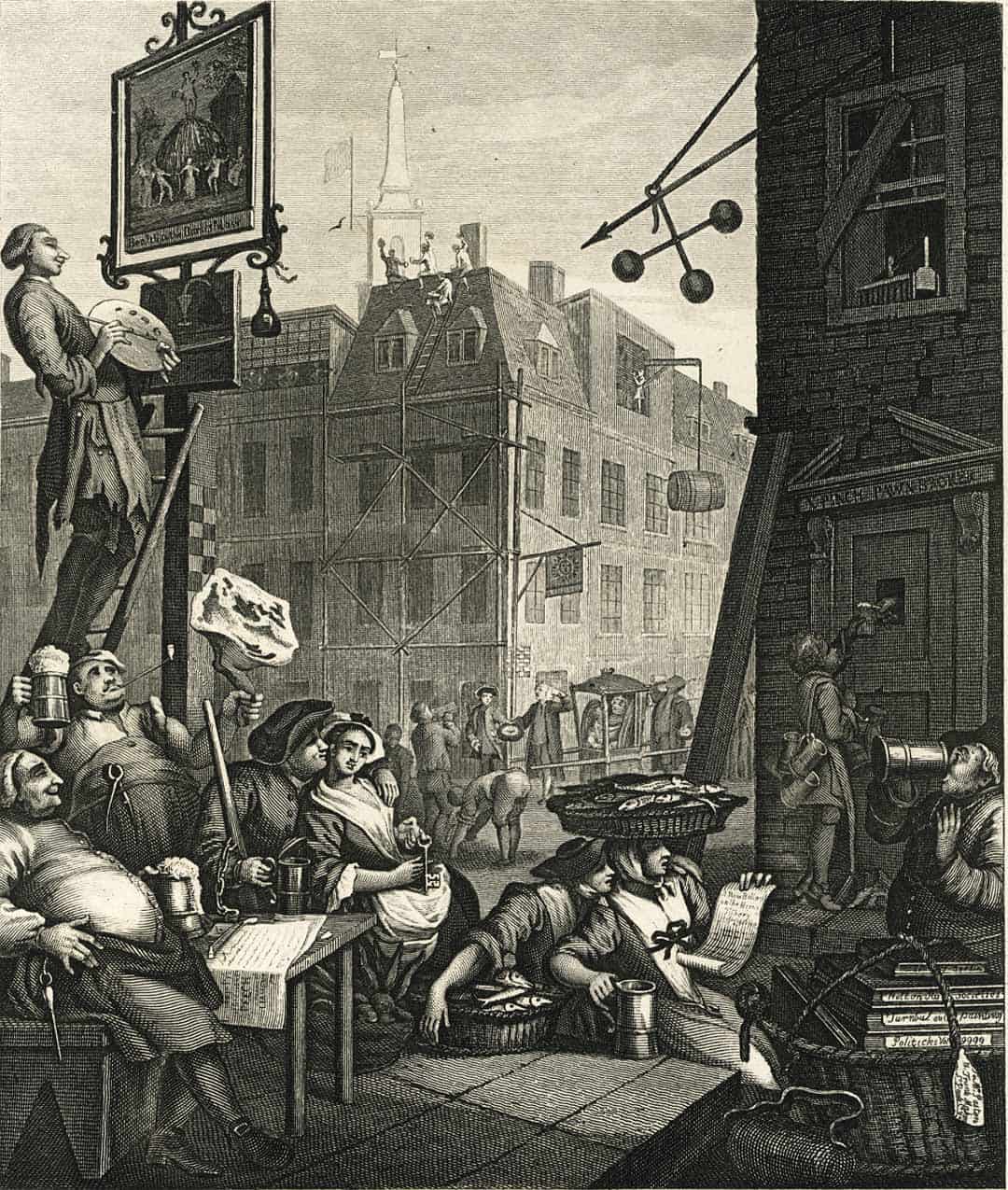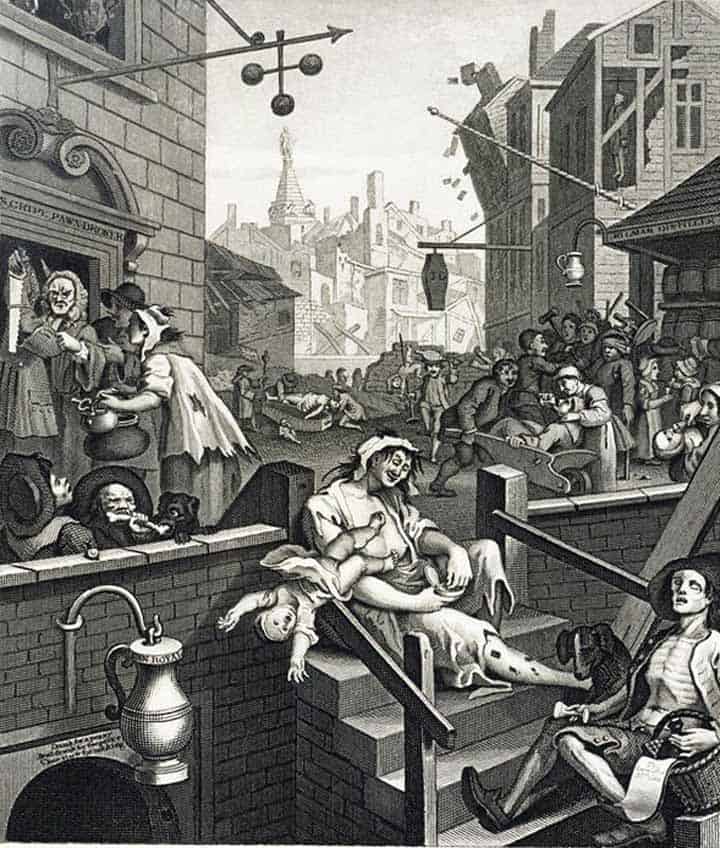





Posts
-
Recent Posts
- Plants with Glass
- Cactus & Succulents
- NATURE
- Gazebo
- Florida Advertising Jugs
- Early Sodas of the Carolinas
- David P. Wilber and Anthony Gugliotti Barber Bottle Collections
- American Antique Glass Masterpieces
- Facts, Assumptions, and Stories about Round-Bottom Bottles
- Early Georgia Sodas
- Bitters Bottles Supplement 2
- Daily Dose | September 2025
- Daily Dose | October 2019
- Daily Dose | September 2019
- Looking at a Moffat Billhead
Recent Comments
- Ferdinand Meyer V on Barrel Series – Original Pocahontas Bitters
- The Life and Times of E.H. Taylor – E.H. Taylor, Jr. on A question regarding an “Old Taylor” find
- Froggy on The Triangular O.H.P. Rose’s Peruvian King Bitters
- etmcguire on Dr. Jaffe’s Celebrated Cinchona Bitters Trademark Letter
- mikedickman on Daily Dose | April • June 2 0 1 7
- gregtbr on The Triangular O.H.P. Rose’s Peruvian King Bitters
- Bocabottle on Early Damiana Bitters or is something wrong here?
- texas bottle man on Confederate Stomach Bitters – Angelo Velati – Columbus Georgia
- texas bottle man on Confederate Stomach Bitters – Angelo Velati – Columbus Georgia
- mikedickman on Daily Dose | July 2016
Archives
- October 2025 (4)
- September 2025 (4)
- January 2024 (1)
- October 2021 (1)
- December 2020 (1)
- November 2019 (1)
- October 2019 (1)
- September 2019 (1)
- August 2019 (2)
- July 2019 (1)
- June 2019 (1)
- May 2019 (4)
- April 2019 (4)
- March 2019 (5)
- February 2019 (7)
- January 2019 (7)
- December 2018 (8)
- November 2018 (7)
- October 2018 (11)
- September 2018 (6)
- August 2018 (3)
- July 2018 (1)
- April 2018 (2)
- March 2018 (4)
- February 2018 (2)
- January 2018 (1)
- December 2017 (1)
- October 2017 (7)
- August 2017 (1)
- July 2017 (3)
- June 2017 (6)
- April 2017 (1)
- March 2017 (1)
- February 2017 (1)
- January 2017 (3)
- October 2016 (4)
- September 2016 (3)
- August 2016 (3)
- July 2016 (3)
- June 2016 (1)
- May 2016 (2)
- April 2016 (1)
- March 2016 (8)
- February 2016 (8)
- January 2016 (5)
- December 2015 (3)
- November 2015 (17)
- October 2015 (14)
- September 2015 (11)
- August 2015 (6)
- July 2015 (4)
- June 2015 (9)
- May 2015 (15)
- April 2015 (13)
- March 2015 (16)
- February 2015 (21)
- January 2015 (21)
- December 2014 (24)
- November 2014 (22)
- October 2014 (29)
- September 2014 (16)
- August 2014 (27)
- July 2014 (26)
- June 2014 (23)
- May 2014 (27)
- April 2014 (27)
- March 2014 (36)
- February 2014 (39)
- January 2014 (40)
- December 2013 (28)
- November 2013 (35)
- October 2013 (41)
- September 2013 (42)
- August 2013 (42)
- July 2013 (38)
- June 2013 (38)
- May 2013 (35)
- April 2013 (38)
- March 2013 (43)
- February 2013 (28)
- January 2013 (37)
- December 2012 (44)
- November 2012 (37)
- October 2012 (50)
- September 2012 (44)
- August 2012 (48)
- July 2012 (47)
- June 2012 (40)
- May 2012 (49)
- April 2012 (42)
- March 2012 (45)
- February 2012 (36)
- January 2012 (43)
- December 2011 (38)
- November 2011 (54)
- October 2011 (31)
- September 2011 (31)
- August 2011 (43)
- July 2011 (36)
- June 2011 (23)
- May 2011 (38)
- April 2011 (75)
Categories
- Advertising (467)
- Advice (272)
- Ales & Ciders (38)
- Ancient Glass (7)
- Apothecary (59)
- Art & Architecture (72)
- Art Glass (3)
- Article Publications (153)
- Auction News (243)
- Barber Bottles (7)
- Bartending (2)
- Bitters (1,018)
- Black Glass (11)
- Blacking (4)
- Blown Glass (38)
- Bottle Shows (250)
- Bottles and Extras (44)
- Bottling Works (36)
- Bourbon (29)
- Bowls (5)
- Brandy (3)
- Breweriana (45)
- Candy (1)
- Carnival Glass (3)
- Chamber Pot (1)
- Chestnut (10)
- Civil War (104)
- Club News (158)
- Cod Liver Oil (4)
- Coffee (1)
- Cola (11)
- Collectors & Collections (724)
- Cologne (27)
- Color (26)
- Color Runs (174)
- Cordial (40)
- Currency (13)
- Daily Dose (53)
- Decanter (9)
- Demijohns (27)
- Depression Glass (6)
- Digging and Finding (318)
- Dinnerware (14)
- Display (79)
- Diving (17)
- Druggist & Drugstore (270)
- Early American Glass (132)
- eBay (147)
- Ephemera (228)
- Errors (1)
- Eye Cups (1)
- Facebook (63)
- Figural Bottles (310)
- Fire Grenades (5)
- Fishing Floats (2)
- Flasks (146)
- Fly Traps (2)
- FOHBC News (165)
- Folk Art (22)
- Food (1)
- Freeblown Glass (27)
- Fruit Jars (40)
- Gin (34)
- Ginger Ale (14)
- Glass Companies & Works (113)
- Glass Makers (68)
- Hair Tonics (25)
- Historical Flasks (114)
- History (945)
- Holiday (31)
- Humor – Lighter Side (89)
- Hutches (12)
- Infant Feeders (3)
- Inks (47)
- Insulators (42)
- Jelly & Jam (6)
- Juice and Ades (1)
- Lamps (3)
- Legal (9)
- Lightning Rod Balls (13)
- Liqueurs (8)
- liquor (24)
- Liquor Merchant (244)
- Mailbox Letters (20)
- Marbles (7)
- Medicines & Cures (589)
- Milk & Creamers (22)
- Milk Glass (10)
- Mineral Water (49)
- Miniatures (22)
- Museums (73)
- News (401)
- Painted Label (7)
- Paperweights (3)
- Passing (1)
- Patents (3)
- Peachridge Glass (48)
- Pepper Sauce (8)
- Perfume (20)
- Photography (143)
- Pickle Jars (23)
- Pitchers (7)
- Poison Bottles (22)
- Postage (25)
- Pot Lids (14)
- Pottery (13)
- Pressed Glass (1)
- Price Guides (3)
- Publications (63)
- Questions (341)
- Regulations (6)
- Remedy (63)
- Reproductions (6)
- Revolutionary War (14)
- Root Beer (4)
- Rum (2)
- Salt (4)
- Salve (3)
- Sarsaparilla (38)
- Sauce (5)
- Scams & Frauds (18)
- Scents (4)
- Schnapps (18)
- Sea Glass (3)
- Seltzer (2)
- Shaving Mugs (5)
- Shot Glasses (8)
- Snuff (10)
- Soda Bottles (40)
- Soda Water (41)
- Soft Drinks (17)
- Spanish-American War (1)
- Spirits (170)
- Stained Glass (6)
- Stoneware (21)
- Syrup (13)
- Target Balls (7)
- Tax Stamps (40)
- Tea (2)
- Technology (36)
- Temperance (3)
- Tobacco (15)
- Tonics (179)
- Trade Cards (106)
- Treasure (6)
- Uncategorized (25)
- Utility Bottles (53)
- Vases (7)
- Veterinary (7)
- Virtual Museum (13)
- Water (12)
- Whimsies (14)
- Whiskey (165)
- Windows (15)
- Wine & Champagne (48)
- Witch Ball (4)
A few of us Bottle Collectors got together in Manchester
Posted in Art & Architecture, History, Humor - Lighter Side, News
Tagged Brian Wolff, Manchester
1 Comment
Determining bottle color standards with Peachridge 6-Log Drakes
Determining bottle color standards with Peachridge 6-Log Drakes
14 September 2013
![]() Michael Seeliger (Brooklyn, Wisconsin) recently visited us at Peach Ridge where Mike took exacting color measurements of my 6-log Drakes Plantation Bitters run and various other bottles using a color spectrophotometer that he designed. The device, which is pictured below, is carefully lowered into each bottle and a color reading is taken. This is only after it has been carefully calibrated using pieces of stained glass.
Michael Seeliger (Brooklyn, Wisconsin) recently visited us at Peach Ridge where Mike took exacting color measurements of my 6-log Drakes Plantation Bitters run and various other bottles using a color spectrophotometer that he designed. The device, which is pictured below, is carefully lowered into each bottle and a color reading is taken. This is only after it has been carefully calibrated using pieces of stained glass.
The eventual goal will be to measure enough bottles to get a standard chart of bottle and glass colors. So down the road you might have the following for some of the greens. Two amber readings are also listed.
3138 – Teal Green
3646 – Forest Green
3845 – Grass Green
4146 – Citron Green
4547 – Moss Green
5344 – Light Amber
5544 – Amber
This is pretty exciting work as color is subjective and is seen differently by each person. Having a standard might help a person understand a bottle color before it is added to a collection. Of course nothing will ever replace seeing a bottle color with your own eyes under various lighting conditions. I believe Mike is headed to Jeff Burkhardts to do the same process with his wonderful Drakes.
Read More: Color Measurement – Latest from Michael Seeliger
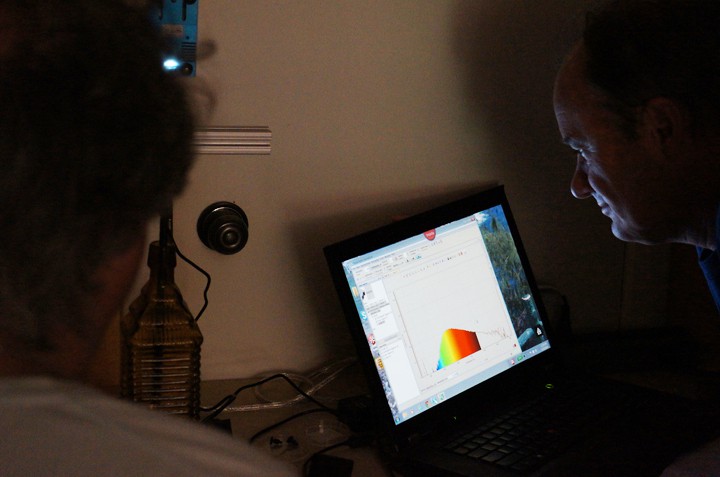
That is Mike on the right reading a color graph from a greenish Drakes in front of me on the left. We set up in a dark, back hallway to the laundry room as to not have any other natural light influence.
Posted in Bitters, Color, Color Runs, Figural Bottles, Technology
Tagged Color, Drakes, Michael Seeliger, Reading, spectrophotometer
Leave a comment
C. T. Hughes & Co. Sauce Bottle – Where is it from?
C. T. Hughes & Co. Sauce Bottle
Where is it from?
13 September 2013
![]() The other day we read about the dig with all of the pontiled bottles. Read: The One We Have Waited For, Privy Heaven!!!! The bottle that really caught my attention, not only because it was a nice photograph, was the C. T. HUGHES & CO. What a great shape for a sauce bottle. It reminded me of the Wells, Miller & Provost cathedral sauce bottles.
The other day we read about the dig with all of the pontiled bottles. Read: The One We Have Waited For, Privy Heaven!!!! The bottle that really caught my attention, not only because it was a nice photograph, was the C. T. HUGHES & CO. What a great shape for a sauce bottle. It reminded me of the Wells, Miller & Provost cathedral sauce bottles.
The information with the Privy Heaven post did not list a locale, city or even the diggers names. I can understand that. After looking at the pictures, I started blowing up the logos on the shirts and hats, looking at street signs and other clues that might give me some support info to aid in a search. Just searching C. T. Hughes & Co. was pulling up no leads. I started guessing Charleston, Memphis, Philadelphia and some of the other usual suspects. When I asked about information on the bottle on facebook I got a few hits:
“I had one of the Hughes like this that was embossed Cincinnati”- Joe Hardin
“That C.T. HUGHES peppersauce is probably the rarest bottle those guys dug, unlisted and I have never seen or heard of this one! I do have a C.T. HUGHES large cylinder pickle (missing top) that is also unlisted” – Dennis Rogers
“My understanding is that this was dug in Indiana and the food bottle may be from Cincinnatti, Ohio” – Andy Goldfrank
Andy even provided a link for the following listing:
Once getting the Cincinnati information, the rest came together in rather short order. It looks as though Charles T. Hughes was only in business for one or two years after coming from a family grocery business.
Hughes & Glenn, grocers, s. s. 5th, b. Vine and Race, Cincinnati Directory 1849-50
Hughes Charles T. clk. e.s. Plum b. 4th and 5th, Cincinnati Directory 1849-50
Hughes Wm. P. (H. & Glenn) e.s. Plum b. 4th and 5th, Cincinnati Directory 1849-50, 1850-51
Glenn John G. (Huges & G), n. s. 4th. b. Lawrence and Pike, also 128 e. 4th, Cincinnati Directory 1849-50, 1850-51
C. T. Hughes, & Co. 1 Hopple’s Alley, put up pickles, preserves, sauces, catsups, and hermetically sealed articles, warranted to keep in all climates. Their customers are in every part of the south and south-west, Sketches and Statistics of Cincinnati in 1851
Pickles, Vinegar Maufacturers, Hughes Charles T. 1 and 4 Hopple’s alley, Cincinnati Directory 1851-52
HUGHES CHARLES T, manuf. pickles, catsups, sauces, &c. 1 & 4 Hopples alley, h.e.s. Plum b. 4th & 5th, , Cincinnati Directory 1851-52
Hughes, C T, 166 Plum, Cincinnati Directory 1853
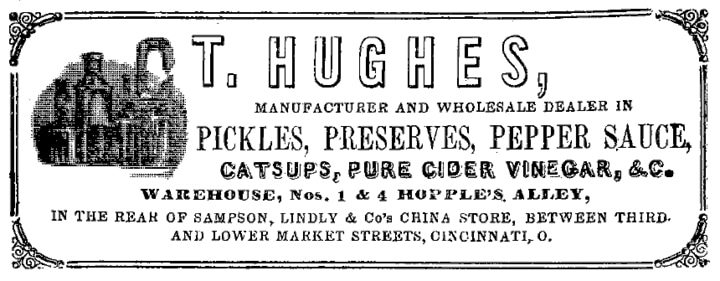
C. T. Hughes advertisement, Manufacturers and Wholesale Dealer in Pickles, Preserves, Pepper Sauce, Catsups, Pure Cider, Vinegar, &c. – Cincinnati Directory, 1851-52
Cincinnati 1853
Lou Pellegrini Sauce Display – 2012 Reno Expo
The Dowesburgh/Albany Glass House 1785-1815
The Dowesburgh | Albany Glass House
1785 – 1815
Part 4 of a Series
by Stephen Atkinson
11 September 2013
Leaving the town of Albany, New York, heading west on Route 20, you will arrive in Guilderland, about six miles west of Albany. Not much remains from the colonial era however, just after the Revolutionary War, Leenert De’Nuefville, who had raised a half million pounds towards the Colonists cause against England, was in need of cash again.
Leeenert was of Dutch origon and knew that the only way early villages could survive was to establish manufactories.
Leeenert was of Dutch origon and knew that the only way early villages could survive was to establish manufactories. Leenert was contacted by a Dutchman, Johannes Heefke, who earlier in the year of 1782, wrote John Adams the following letter from the archives of the Library of Congress in the Adams family papers:
Johannes Heefke to John Adams, Amsterdam, 7 June 1782
Distinguished Sir!
For a long time I have had an ardent and avid desire to be in North America, but never did my wish come true: for three long months it seemed as if I would be able to get there; I asked Mr. Willem Hooft (who knows me) whether this honorable gentleman might help me. This particular gentleman sent me to Mr. Jean de Neufville, who did not only allow me this favor graciously but also promised to help me once I got there. Nonetheless I had to wait two more months before a ship of this honorable gentleman left thereto. But alas! When the two months had gone by he notified me that he had neither ship nor opportunity to help me. So I pondered my problem and tried to think of a solution. In the meantime I found out that there is a gentleman here who has a considerable amount of vacant and uncultivated land in North America for sale, both in Canada and north of Albany on the river which leads to New York, but so far he has not sold anything yet. Part of these lands could well be used by glassblowers.
Sadly, I lack the means, for if I had them I would be able in a few years to turn thousands of acres of fallow land into fertile land. I have run a strong business in my country around Mecklenburg, but I had to discontinue it because of a lack of wood; I could run the most beautiful business if only I knew of a way to help my lack of means. Great minister, do not be angry with a man who begs you for a favor. I know that your excellency has a charitable disposition and that you like to make people happy; and I would be greatly helped by your mediation and distinction, and I would be one of the happiest people in the world; I would show that I would know how to get the most from such a piece of land. Thus your excellency would not have to be ashamed of your charity, but you would have nothing but pleasure from it. You can help me in the following way: by mediating, and through your distinction I would be able to pay off in the next few years the gentleman who has his land for sale. It will be good business for him, too. And he could give me a loan, which I would pay off the next two years with ease.
The piece of land by the big river that is cut through by a small river would be very suitable for such an enterprise. It amounts to 15,000 acres and would cost f12,000 plus the money that would be required for such an enterprise, which would amount to 7,000. Because I would need more than thirty glassblowers of whom the tools and transport would be the biggest burden. However, once they would get to work, they would be able to produce 1,000 to 1,200 cases of glass in four years. With the exception of the many thousands of bottles that would be counted as wages, I could in this way (if I charged 10 for every case) save 10,000, which I would use to pay off the land in four years. I would be such a happy man if I could do that! All because of your excellency! I do not need more than upwards of 2,000 florins in hand, and with this I can buy several pieces of decent land, which would be sincere proof of my honest and decent livelihood and existence.
The rest could, if you agree with this, be sent or be delivered by an emissary. The same person could henceforth inspect my enterprise. An honest man is not afraid of such inspections. Honorable great minister! Of a happy country! It would be easy for your honorable excellency to help me because you are a man with so much distinction (and you are a man who has been here twelve years and has wrestled with all imaginable adversity). I will not lack in vigilance. With good reason I can flatter myself that I know the economy and the particularities of the land and the cultivation of the land; in addition I understand the various arts. Once again, great minister, I beg you to make my wish come true. I will accept your decision with resignation. I am your humble servant. Please, your excellency, you can send me your decision in a few words. I beg you to forgive me for these liberties I took. Your excellency, In case your excellency honors me with a letter, my address is in care of widow Altinaa at the Achter Burchwal at the Emder or Frisian post office.
Your humble servant,
Jan Heefke
No help from John Adams was forth coming, however this did not stop the plan to establish a glasshouse. In May 1785, Heefke and his partner Ferdinand Walfahrt signed a contract on May 12th, 1785 with Leendert de Neufville, Jean de Neufville’s son, to establish a glasshouse at Dowesburgh (now Guilderland), New York, about eight miles from Albany.
The glass house was located near the banks of the Hungerskill River just south of the stage road leading eastward towards Albany.
Experienced glass workmen had been brought from Germany, and the building of the new factory had begun in the winter of 1786. The glass house was located near the banks of the Hungerskill River just south of the stage road leading eastward towards Albany. Heefke named these early works the Dowesburgh Glass House. The blowing of glass commensed in the spring of 1786 as the glass blowers from the Palatinate region from Germany began to produce glass. They made hollow ware (utility bottles) but the main output was window glass. Guilderland, in the mid 1700’s, was still a wilderness and was chosen for glass-making rather than a location nearer to Albany, where civilization and transportation were close at hand. The reason is quite simple, for the present town of Guilderland had all the raw material necessary for the manufacture of glass along with the necessary wood for the furnaces and potash for the making of the glass. Waterpower from the Hungerskill, and an abundant supply of sandy soil were all the ingredients needed for this venture.
The aerial photo below from Google earth shows the exact location of the colonial glass works in present day Guilderland, New York, just 8 miles west of Albany New York.
The works survived for two years but soon Heefke and his partner Walfahrt were running out of capital to run the factory. They along with de’Nuefville, appealed to the State of New York for 30,000 pounds in order to keep the glass works going. Their initial appeal was rejected by the state. However, in 1789, Leenert de Neufville again solicited the legislature for funds, and on March 3, 1789, both the Senate and the Assembly granted him a loan of 1,500 pounds to carry on the glass works. As was the case with so many glass houses before them, they soon began to experience additional monetary problems and in 1791, the glass works were bankrupt and out of business. Leenert de Neufville ultimately became depressed and abandoned his interests in the glass works. He died in 1796 in Albany, leaving his widow destitute.
as the state of New York realized it was very important to have this manufactory located near the capitol city
This was not the end of the venture as the state of New York realized it was very important to have this manufactory located near the capitol city and soon a company was formed. In 1793, a petition for state aid for the Glass House was submitted in the name of McClallen, McGregor & Company and the principals were James Caldwell and Christopher Batterman, later Sheriff Batterman of Anti-Rent War fame. The State granted a loan of 3,000 pounds for eight years; three interest free, and five years at five percent. In the year 1795, the Glass House was twice reorganized, first as McGregor & Co., and then as Thomas Mather & Co.
Below is an advertisement from the June 1st 1793 edition of The United States Gazette Newspaper out of Philadelphia from my collection.
I am sure that Demijohns like the ones pictured below, were made at this factory.
In 1796, the state Legislature passed an act that exempted the company and the workers from all taxes for five years as encouragement for consolidating the glass works into a permanent manufacturing town. It was named Hamilton, in honor of Alexander Hamilton, the first Secretary of the Treasurer, who was influential in obtaining a $3,000 grant for the widow de Neufville. In 1797, the company was again reorganized under the name of of the Hamilton Manufacturing Society. The directors of this new company were the following gentleman; Jeremiah Van Rensselaer, John Sanders, Abraham Staats, and Thomas Mather of future Connecticut glass house fame.
By 1813, the glass works were producing 500,000 feet of window glass annually, along with utility bottles and demijohns.
The glass works were run successfully for 17 years by this firm which changed from time to time. By 1813, the glass works were producing 500,000 feet of window glass annually, along with utility bottles and demijohns. The factory employed over 50 workers, whom were living in company houses, of which two can be seen today along Route 20, then known as the Great Western Turnpike. Company housing was typical of the times when people lived as close to work as possible. In addition to the company housing, the glass works also operated a company store, where all necessities, such as food and clothing, were purchased at a premium price with company script. In 1815, due to the lack of wood which had been depleted and the sand deposits which were running out, glass-making in Guilderland factory had ceased.
The success of these glass works inspired glass making throughout the State of New York
Glass fragments found in the Hungerskill stream show that the color of glass that was being produced at the factory was dark green for hollow ware but pale green in color for the flat crown window glass which was also found in abundance. The type of glassware and bottles made here was very utilitarian in nature but I am sure offhand pieces were also made at these works just as they were at others before and after them. Window glass was the mainstay of production as their glass was shipped away as far as Baltimore to the south and all of New England to the East and North. These glass works were the last of the 18th century incorporated manufactories in the State of New York. The success of these glass works inspired glass making throughout the State of New York and the nineteenth century would see over 30 additional glass works constructed in all regions of the state.
About Stephen Atkinson
Stephen Atkinson, from Sewell, New Jersey has been collecting bottles and glass since he was 12 years old. He once dug an original EG Booz figural cabin bottle on Norris Street in Mantua, New Jersey in 1972 at 12 years old and traded it for six bitters bottles. Fast forward to 2012 and Stephen bought the exact bottle back at an estate auction in New Jersey!
His passion is for pre-1880 glass, as the majority of his collection consists of historical flasks, colonial era chestnut bottles, and whimsical end of day pieces of glass. He also has three rare T.W. Dyott bottles, an original Dr. Robertson’s family medicine; one of the rarest collectable American bottles, a T.W. Dyott vial bottle dug by Chris Rowell and a paper labeled T.W. Dyott bottle. He has researched many southern New Jersey glass works first hand by locating the original factory sites. The best piece in his collection is the Wistarburgh Glass Company ledger showing monies paid out to Caspar Wistar’s Children and their husbands and wives.
Read more Stephen Atkinson articles in this series:
The New York State Glass Factories | Preface to a Series
Newburgh (Glass House Co.) 1751-1759 | Part 1
Brooklyn (Glass House Co.) 1754-1758 | Part 2
Posted in Article Publications, Blown Glass, Demijohns, Digging and Finding, Early American Glass, Glass Companies & Works, Glass Makers, History, Utility Bottles, Windows
Tagged Abraham Staats, Albany, Amsterdam, Anti-Rent War, Christopher Batterman, Demijohn, Dowesburgh, Ferdinand Walfahrt, Guilderland, Hamilton, Hamilton Manufacturing Society, Hungerskill, James Caldwell, Jeremiah Van Rensselaer, Johannes Heefke, John Adams, John Sanders, Leenert De'Nuefville, McClallen, McGregor, McGregor & Co., New York, Stephen Atkinson, Thomas Mather & Co.
Leave a comment
Newburgh (Glass House Co.) 1751-1759
Newburgh (Glass House Co.)
1751 – 1759
Part 1 of a Series
by Stephen Atkinson
11 September 2013
The manufacture of glass was commenced in the village of New Windsor near present day Newburgh, 66 miles north of New York City, sometime mid to late 1751 by a company from New York City of which Christian Hertell, Samuel Bayard, Lodewyck (or Lodewick) Bamper and Mathias (or Matthew) Ernest were partners, the first named being the resident manager. This group hired master gaffer, Johann Martin Greiner of Saxe-Weimar in the Palatinate region of present day Germany to design, help construct the glass works, be the master gaffer and train the new help.
Mr. Grenier was part of the famous (French-German) glass blowing, factory owning Greiner family who had been manufacturing glass from the early 1500s. These wealthy Dutch gentleman were partners of a company named the Glass House Company and were based out of New York City. The following agreement recites the purchase of lots for the purpose and other matters connected with it:
Memorandum that we, the subscribers, have this third day of January, 1751, agreed with Vincent Matthews, who acts in behalf of Samuel Bayard, in New York, for a parcel of lots lying and being at New Windsor, being part of the lands we purchased from John Alsop at New York, in the following manor, that is to say: We, the said subscribers, do agree to sell the following lots with, the prices there unto annexed, viz:
James Tuthill, lots 21 and 58, for £0 9 o o
Henry Brewster to Brant Schuyler, lots 22 and 59 for o 7 o o
Evan Jones, lots 22, and 56 for o 7 o o
John Yelverton, lot 57 for o 3 o o
Hezekiah Howell, lot 43 for o 2 o
Joseph Sackett, lot 71 for 3 o o
Ebenezer Seeley, lot 68 for o 3 o
Vincent Matthews, lot 69 for o 3 o
John Nelson, lot 70 for o 3 o 4000
“Provided, nevertheless, that as the chief reason for selling the above lots at such a low rate and under value, is upon this account, viz: To encourage the said Samuel Bayard & Company for the building and erecting a glass-house for making of glass and potash, which the said Bayard & Company have agreed to erect upon some of the above said lots; but in case the said Bayard & Company should fail, and throw up, and not build the said works, then and in such case the above agreement to be void and the lots to remain to the above owners; and we, the above owners and subscribers, do hereby acknowledge to have received from the above Samuel Bayard, by the hands of Vincent Matthews, the full one equal half part of the above mentioned sum of forty pounds, being half of the above purchase money, and we do promise and agree to execute, each for himself and for his heirs, good and lawful deeds to the said Samuel Bayard & Company, each for his Share or part of the above lots, upon the said Samuel Bayard’s paying the rest or the other half of the above purchase money which said half is to be paid on or before the twenty-fifth day of March next ensuing the date hereof – which said deeds are to be at the proper cost and charge of the said Bayard & Company.”
“In witness whereof, we have hereunto set our hands the day and year first above written. Signed in the presence of us, Fletcher Matthews, Thos. Jones.”
“Be it remembered. That I, Christian Hertell, in company with the within Samuel Barard, Lodewick Bamper, and Mathias Ernest, did agree to the written purchase made by Vincent Mathews, with the within Proprietors of New Windsor; and do agree for myself and the rest of the company to fulfill the said agreement; and if we fail of building the said glass-house and quit it, then and in such case to release all the said lots back again to the owners thereof upon their returning the purchase money back to me and Company again, or to any of us, as witness my hand this first day of April, 1752. “C. R. HERTELL & COMPANY.
“Signed and acknowledged and delivered in presence of us, Ebenezer Seely, Jr., Judah Harlow.”
The works were conducted for a number of years until after the war of the American Revolution. Based on the archaeological finds of mainly dark green glass at the original factory site, the types of bottles and glassware made at these works are as follows:
Case bottles, the tall square in shape type with high kick-ups in the corners to help stabilize contact on all four corners.
Large wine bottles with string lips made closely in the style of the German mallet type bottles.
Medicine vials, with sheared tops,
Square utility bottles with tapered and chamfered corners.
Large utility bottles in one, two and three gallon sizes all with deep conical bases.
A little history concerning Mr. Greiners roots:
The Glassworks at Munzthal in the year 1585
Henry Heigel writes in his article the German Ballai (1600-1633) that Martin Greiner and Simon Stenger had moved the glass works from Holbach to Munzthal in 1585. In 1601 the glass-master Martin Greiner, paid 80 floren for his glas-haus and eight partners, (Siegwalt Steffel, Hensel Schurer, Ulrich Scheidhauer, Hans Shirer von Petersback, Hans Greiner, Paulus Glaser, Andres Spessart, and Henre Wincker). In 1603 there were ten glass makers at the factory as output had increased.
In the year 1609 there were fourteen glass-makers; Martin Greiner, Jean Houber, Adam and Gaspard Greiner, Nicholas Krebs, George Hoff and Sebastian Ehrlich. The widow of Martin Greiner was allowed to open up one of the huts in a different location.
The first glass works from 1585 had depleted the forest area. It was reported that in 1613 that the glass works from Martin Greiner was located at the end Munzthal.
His son, Jean Greiner operated the glass-house in 1614. Jean Greiner had two sons Nicolas and Leonard who worked for their father. In 1625, both being the new masters of the glass works, Nicolas and Leonard Greiner, employed ten workers including Martin Siegwart, Adam Greiner and Andres Stenger.
The old widow Greiner, planned to give up the lease for the hut because of lack of wood. There were still eleven workers employed in 1629 including Koch, Steffel, Contz, Andres, Stenger, Sigeart, Adam Greiner, Jean Schwan.
As you can see, it is obvious why the Glass House Company sought the expert advice from Johan Martin Greiner, one of the most famous glass makers from Germany at the time. The Greiner family had been manufacturing glass in Germany for 150 years prior to his arrival in New York City in 1750. Johan would go on to be hired by Wilhem Henry Stiegel who used Johan Martin Greiner to design all three of his glass works built over a ten year period at Elizabeth and Manheim, Pennsylvania.
The glass works was still in operation at New Windsor for as the advertisement below from December 28th, 1758 edition of the New York Mercury states:
Or the property being sold near the glass works mentioned in this advertisement from the April 2nd 1759 edition of the New York Mercury:
But the end of the glass works was soon to be, for a little over a month later, as listed here in the advertisement below, which was mixed into a long list of regional stories, “The Glass House at New-Windsor, in this Province, was burnt to the ground.” – The Monday, May 28, 1759 edition of the New York Mercury.
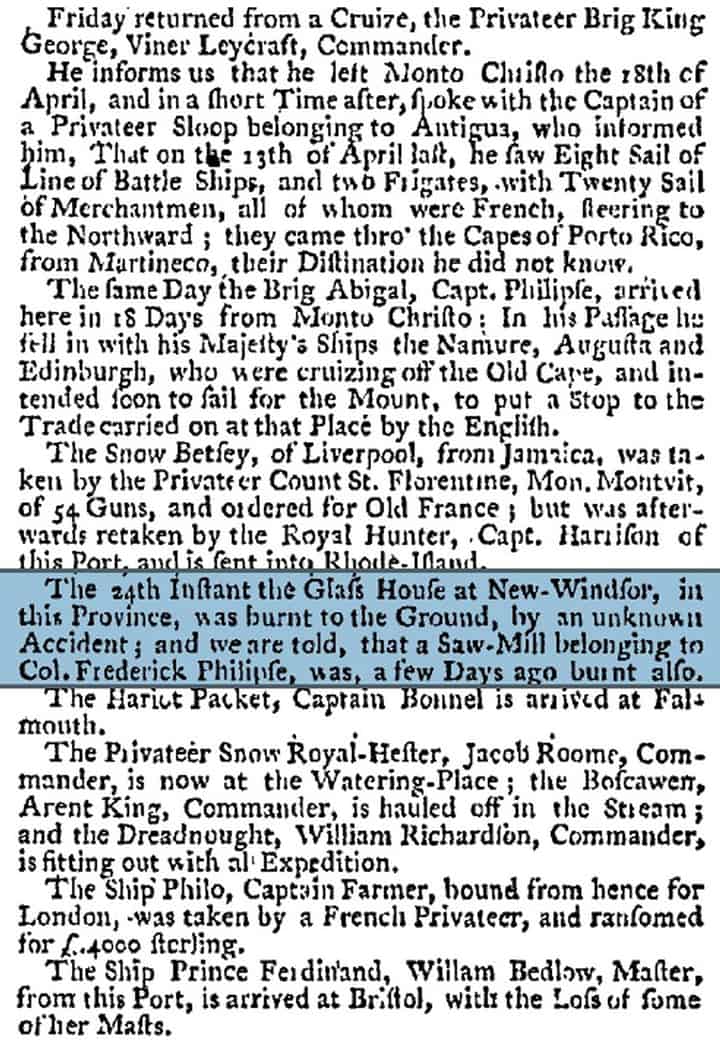
“the Glass House at New-Windsor, in this Province, was burnt to the ground” – Monday, May 28, 1759 – New York Mercury
The glass house demise was mainly due to the disasterous fire and as is the case with most other glass factories, which had been established before and after the forest being depleted, this was another main factor in a glass factorys inability to survive. The North River, as it was known in Colonial times, now the Hudson river, was an excellent means of navigation to and from the city of New York. Plans were already in the works before the fire to build a new factory much closer to Manhattan (New Amsterdam) (New York) by this same group of men.
The bottle below is very typical of the type manufactured at these works:
CASE TYPE BOTTLE
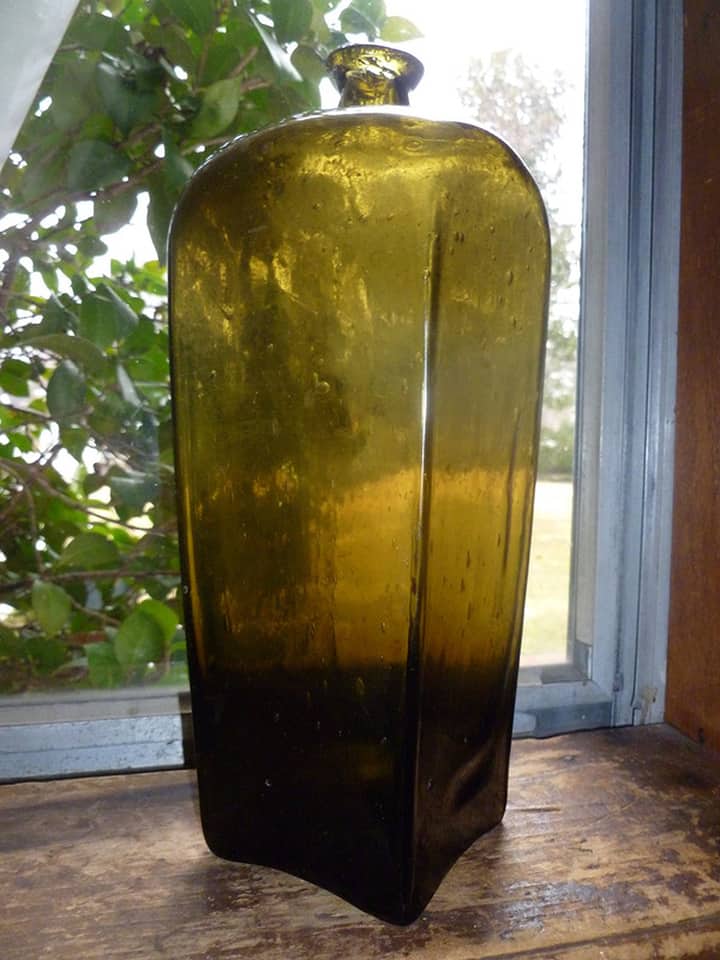
Case type bottle, 14 inches tall, olive amber in color, large deep blow pipe type pontil mark, 1750 to 1770
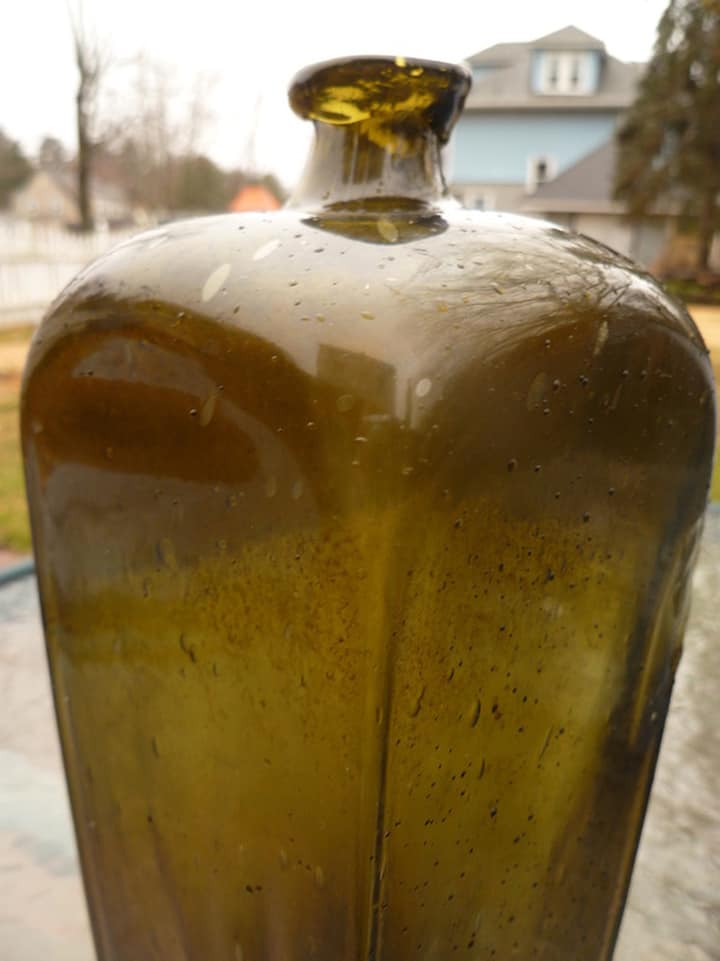
Case type bottle, in close on the shoulders and the lip. Pretty colored bottle with lots of small bubbles.
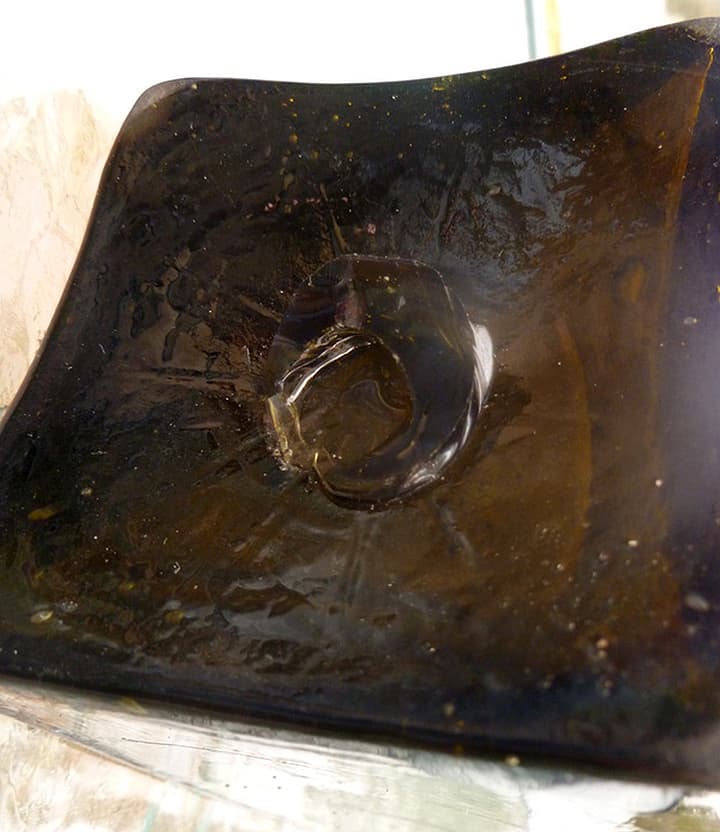
Case type bottle, concave base, deep blow pipe pontil mark with a large chunk of glass extending downward from the perimeter of the pontil mark.
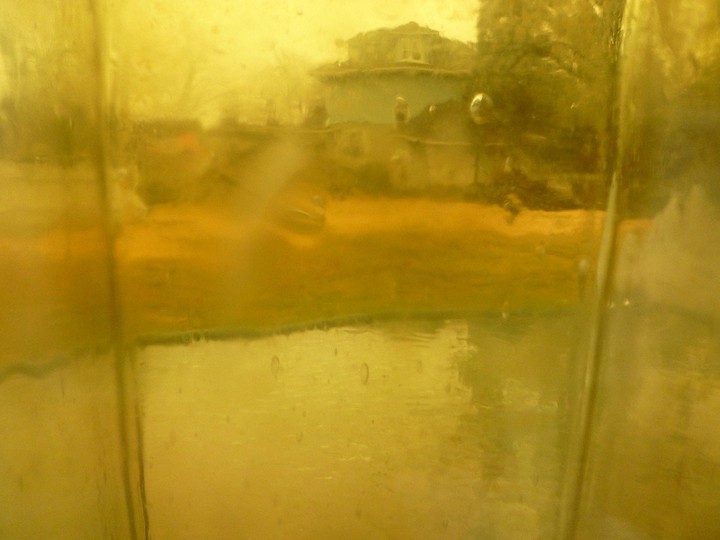
Case type bottle. Looking through 275 year old sun glasses into my back yard at the neighbors huge Victorian home!
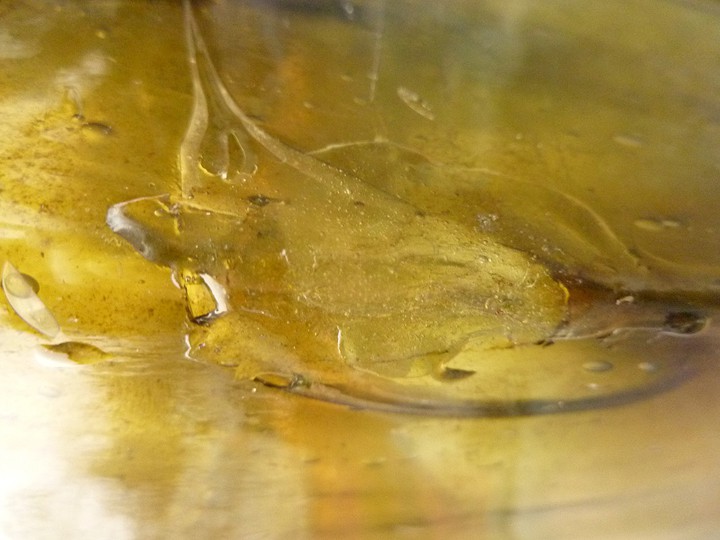
Case type bottle, On the side of the bottle, the shoulder line is a huge bubble which burst and resealed itself in the making. I have never seen this before on glass.
The January 5th, 1969 edition of The Evening News Newspaper of Newburgh, New York had the following headline:
About Stephen Atkinson
Stephen Atkinson, from Sewell, New Jersey has been collecting bottles and glass since he was 12 years old. He once dug an original EG Booz figural cabin bottle on Norris Street in Mantua, New Jersey in 1972 at 12 years old and traded it for six bitters bottles. Fast forward to 2012 and Stephen bought the exact bottle back at an estate auction in New Jersey!
His passion is for pre-1880 glass, as the majority of his collection consists of historical flasks, colonial era chestnut bottles, and whimsical end of day pieces of glass. He also has three rare T.W. Dyott bottles, an original Dr. Robertson’s family medicine; one of the rarest collectable American bottles, a T.W. Dyott vial bottle dug by Chris Rowell and a paper labeled T.W. Dyott bottle. He has researched many southern New Jersey glass works first hand by locating the original factory sites. The best piece in his collection is the Wistarburgh Glass Company ledger showing monies paid out to Caspar Wistar’s Children and their husbands and wives.
Read more Stephen Atkinson articles in this series:
The New York State Glass Factories | Preface to a Series
Brooklyn (Glass House Co.) 1754-1758 | Part 2
Posted in Article Publications, Blown Glass, Early American Glass, Gin, Glass Companies & Works, Glass Makers, History, Medicines & Cures, Utility Bottles, Wine & Champagne
Tagged bottles, case, Christian Hertell, dutch, gaffer, Germany, Glass, Glass House Company, Henry Heigel, Johann Martin Greiner, Lodewyck Bampe, Mathias Ernest, Munzthal, New Windsor, Newburgh, Samuel Bayard, Saxe-Weimar, Stephen Atkinson, Wilhem Henry Stiegel
Leave a comment
Glass House Farm (Glass House Co) 1758 – 1772
Glass House Farm (Glass House Co) 1758 – 1772
Part 3 of a Series
by Stephen Atkinson
10 September 2013
A farm that ran from Fitzroy Road to the Hudson River in what is now the West 30’s in New York City was the site of the last Colonial glass works. It was called The Glass House Farm because of a glass-bottle factory established there in 1758. The factory lasted ten years, but the Glass House Tavern, on the same property, was a popular roadhouse and stage coach stop, up until the Revolutionary War and after.
Around 1800, a small subdivision was laid out, and lots were sold off, in the area roughly bounded by 32nd and 34th Streets between Ninth and Eleventh Avenues. There were three east-west streets named Rapilje, Jersey and Schroepel; and three shorter north-south streets named Moses, Maple and Tulip. The description of the property lists the area still as the Glass House Farm. Refer: Old Streets of New York
The Glass House Company of New York would build its last glass factory in Newfoundland which is in present day, mid-town New York City which was three miles north of the Glass House Company’s headquarters. We find Matthew Ernest placing an advertisement in the newspaper in the Monday, December 11, 1758 edition of New York Gazette or Weekly Post-Boy. He talks of the newly erected Glas-house.
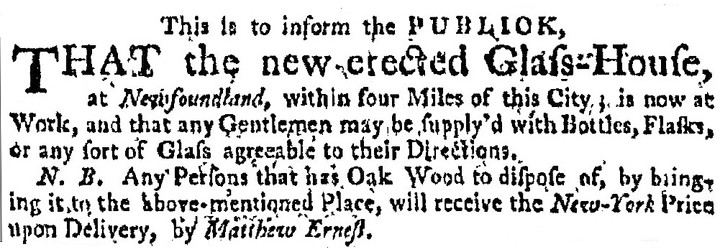
Advertisement from Matthew Ernest announcing the newly erected Glas-house – Monday, December 11, 1758, New York Gazette or Weekly Post-Boy.
Two weeks later on December 23rd, 1758, the following advertisement was placed in the same paper by Matthew Ernest.
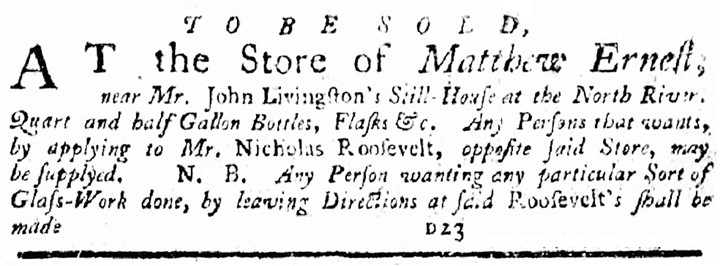
Advertisement from Matthew Ernest announcing “To Be Sold” – Monday, December 23, 1758, New York Gazette or Weekly Post-Boy.
With the year being 1760, these glass works were the only ones left in the New York City vicinity as the Newburgh and Brooklyn enterprises had come to their ends. Unfortunately, one of the founders of the Glass House Company, which oversaw all of these factories, was Samuel Bayard who had passed away in 1758. Matthew Ernests money supply was dwindling and the business mood in general in the Colonies as a whole was not very optimistic. These glass works continued to operate right on up until the start of the American Revolutionary War.
Following the first and largest major engagement of the Continental Army and British troops in the American Revolutionary War, at the Battle of Long Island (also known as the Battle of Brooklyn) on August 27, 1776, General George Washington and the Continental Army retreated to Manhattan Island. The Continentals withdrew north and west and, following the Battle of Fort Washington on November 16, 1776, evacuated the island. For the remainder of the Revolutionary War much of what is now Greater New York and its surroundings were under British control. New York City (then occupying only the southern tip of Manhattan) became, under Lord Howe and his brother Sir William, the British political and military center of operations in North America. David Mathews was the Mayor of New York City during the British occupation.
Correspondingly, the region became central to the development of a Patriot intelligence network, headed by Washington himself. The famous Nathan Hale was but one of Washington’s operatives working in New York, though the others were generally more successful.
The site of the glass factory was north of New York City and was spared some of the horrors of war and it was tough to operate because the North River was being patrolled by the British fleet and shipping and receiving products was difficult at best. Ultimately the war was the most detrimental aspect the factory dealt with and all output ceased when the War of Independence was in full swing. The British were now in control of the city of New York from 1775 through 1776.
The output of this factory did not really differ from the other two works owned by the Glass House Company as all of them made window glass and hollow ware. Glass color again found at the factory site by Fredrick Hunter indicates that dark green glass was used almost exclusively.
With glass blowers from Bristol, England and Germany a very good product line was being turned out. The types of sealed wine bottles in the Van Cortlandt Museum would have been the type still made at this factory. In 1909, workers removing walls and foundation pieces in the old Van Cortlandt home found many sealed F. V. C. 1765 tall wine bottles along with bottles similar in shape but void of the seals. All of these bottles are now preserved in the Van Cortlandt Museum. The works were abandoned during the war as the British were in control of the city.
In the Monday, March 23, 1761 edition of the New York Mercury, Matthew Ernest lists the following long advertisement and he must have sub-divided the property prior, for he lists as for sale, only two thirds of the Glass House. He does state that the works is being operated by a gentleman from Bristol, England with a large work force suggesting the factory was in good operation and that he was probably still selling their wares.
Robert Turlington was advertising quite heavily in New York and Philadelphia newspapers in the late 1750s right through the start of the Revolutionary War. No other nostrum was as counterfeited as Turlington’s Balsam Of Life because Robert was in a constant battle with the agents he hired to sell his medicine in the two cities. A quite likely source of the imitation bottles being sold, that Robert shares with the reader in the New York market, was most likely the Glass House Farm and a gentleman who had dealings with them in the past. They were also just 3 – 1/2 miles to the north and were in business during the time period the counterfeiting began.
I strongly believe that some of the pale green, aqua colored versions of this bottle which appear from time to time pontiled and quite crude, were the earliest attempts of counterfeiting in the 1760 to 1790 time period. All made by workers at the Glass House Farm who had emigrated from the Bristol, England area and who had worked in the glass industry while living there. This was big business and Robert Turlington was hiring and firing agents every few years. Here are a series of notices from New York City newspapers showing the great concern Robert Turlington had for his product.
In the Monday, November 2, 1761 edition of the New-York Mercury newspaper (New York, NY) we find Turlington denouncing Mr. John Milligan who had sold the medicine for Robert Turlington for the past five years. Milligan was accused of selling refilled original bottles and counterfeit ones by Turlington and was no longer considered an agent for the product. Turlington was now including a large paper wrapper around each bottle stating the contents and originality of the product in the bottle. Without this paper, with Turlingtons signature on it, a bottle was considered counterfeit and should be avoided by the consumer.
On the same day he was accused and banned from selling the Turlington Balsam, John Milligan placed an advertisement in the Monday, November 2, 1761 edition of the New-York Gazette (New York, NY) and stated his side of the accusation of impropriety leveled by Robert Turlington. Milligan was not going to go away easily and continued to sell the product at his store even though Robert Turlington forbade him to do so.
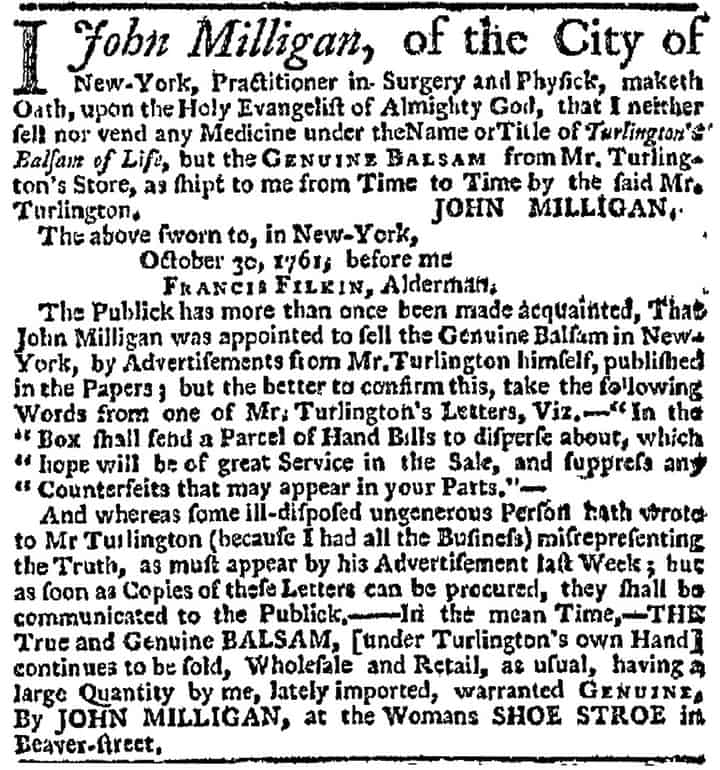
John Milligan placed an advertisement in the Monday, November 2, 1761 edition of the New-York Gazette stating his side of the accusation of impropriety leveled by Robert Turlington.
Here are some of the type of Turlington bottles that may have been made at the Glass House Farm and sold to the public as original medicine imported from England. Most of these were found in the Philadelphia – South Jersey area but I am using these as a reference as to what the imposters may have looked like.
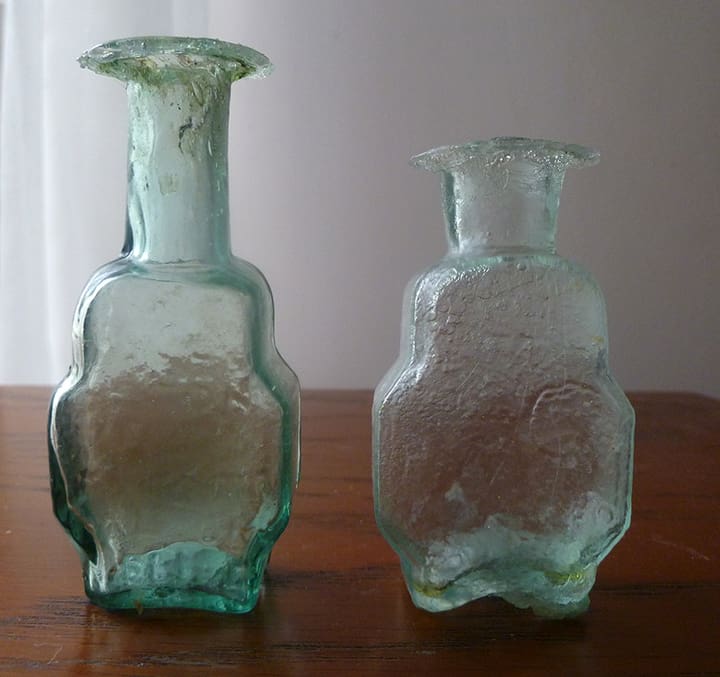
Robert Turlington Balsam bottles from the late 1700s aqua in color and made very crudely. The long neck version is unique, and I have never seen another like it.
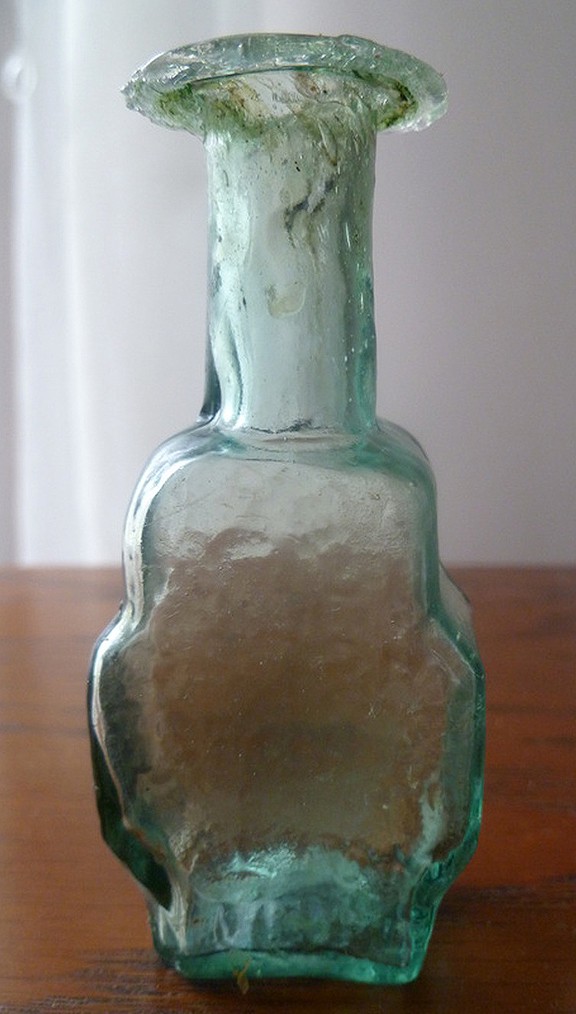
Robert Turlington Balsam bottle. The long necked version close-up from above. Green striations of color in the glass near the lip.
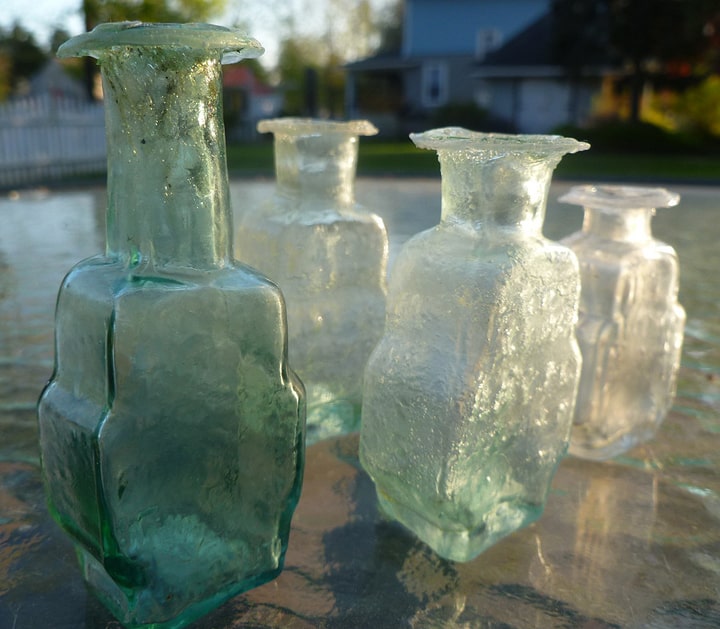
Group shot of four Turlington Balsam of Life bottles. The one on the far right is a British made original example from the mid 1700s.
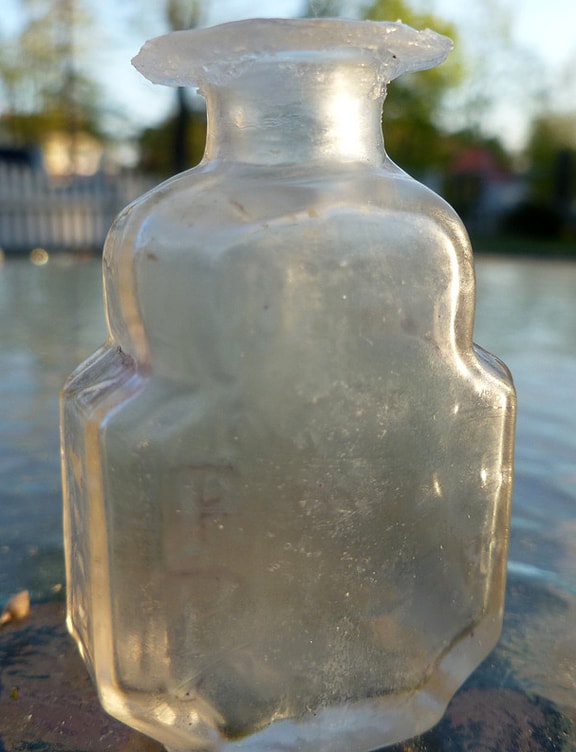
The British ‘Turlington Balsam of Life” example in close has a silvery greyish cast to the clear flint glass.
About Stephen Atkinson
Stephen Atkinson, from Sewell, New Jersey has been collecting bottles and glass since he was 12 years old. He once dug an original EG Booz figural cabin bottle on Norris Street in Mantua, New Jersey in 1972 at 12 years old and traded it for six bitters bottles. Fast forward to 2012 and Stephen bought the exact bottle back at an estate auction in New Jersey!
His passion is for pre-1880 glass, as the majority of his collection consists of historical flasks, colonial era chestnut bottles, and whimsical end of day pieces of glass. He also has three rare T.W. Dyott bottles, an original Dr. Robertson’s family medicine; one of the rarest collectable American bottles, a T.W. Dyott vial bottle dug by Chris Rowell and a paper labeled T.W. Dyott bottle. He has researched many southern New Jersey glass works first hand by locating the original factory sites. The best piece in his collection is the Wistarburgh Glass Company ledger showing monies paid out to Caspar Wistar’s Children and their husbands and wives.
Read more in this series by Stephen Atkinson:
The New York State Glass Factories | Preface to a Series
Newburgh (Glass House Co.) 1751-1759 | Part 1
Brooklyn (Glass House Co.) 1754-1758 | Part 2
Posted in Article Publications, Blown Glass, Glass Companies & Works, Glass Makers, History, Medicines & Cures, Revolutionary War
Tagged Bristol, colonial, England, Fredrick Hunter, George Washington, Glass House Company, Glass House Farm, Glass House Tavern, John Milligan, Matthew Ernest, New York City, Revolutionary, Revolutionary War, Samuel Bayard, Stephen Atkinson, Turlingtons Balsam Of Life, Van Cortlandt Museum
1 Comment
Brooklyn (Glass House Co.) 1754-1758
Brooklyn (Glass House Co.)
1754 – 1758
Part 2 of a Series
by Stephen Atkinson
09 September 2013
A glass works was founded on what would become State Street in the present day Brooklyn, NYC in 1754 by the Glass House Company of New York. It was to be located near one of the partners, Lodewyk Bampers home. These works were the second ones built by the Glass House Company, as three years prior they had founded the glass house 70 miles north in the village of New Windsor, now present day Newburgh.
Johan Martin Greiner again designed the glass works and skilled glass blowers from Bristol and Germany were acquired for this venture. An advertisement placed in the New York Gazette or Weekly Post Boy on October 7th, again on Oct 14th and lastly on the 21st of October in 1754 stated:
The key words in the advertisement are, “Gentlemen that wants Bottles of any size with their names on them”. This is huge in the attribution of North American made sealed gentleman’s bottles. Many glass historians have always dismissed the notion that these type of bottles could have been made here in the Colonies and have just assumed they were always made in Europe in the countries of England, Germany, Holland, France or Scandinavia.
Glass historian Frederick Hunter looked at bottles in the Van Cortlandt Museum with seals impressed upon them of Sidney Breese 1765, and another with the initials F V C which stood for Fredrick Van Cortlandt with the date 1765. After examination, and in his own judgment, Hunter said they looked every bit the type made at Wistarburgh where he had previously found seals walking the grounds of the factory site. Even though Hunter felt the bottles were most likely made at Wistarburgh, and I believe he is incorrect, it has become quite evident to me they were a product in present-day New York City, most likely by the Glass House farm which was in operation in 1765.
Although the Brooklyn Glass Works advertised that they made sealed bottles for gentleman, they most likely were not the makers of the Sidney Breese and Frederick Van Cortlandt bottles in the museum that he saw first hand as the Brooklyn Glass Works was out of business in 1758, seven years prior to the date on the seals.
Fast forward to Monday, August 19th, 2013
A friend of mine, Gary Katzen from Haddonfield, New Jersey and a fellow glass collector with an amazing milk glass collection (Read: Gary Katzen Milk Glass Collection), has in his possession, a bottle with a seal of the initials “P S”. This bottle has been attributed by glass collectors and glass historians to Peter Stuyvesant, who served as the last Dutch Director-General of the colony of New Netherland from 1647 until it was ceded provisionally to the English in 1664, after which it was renamed New York.
By doing a little research, it becomes quite apparent that this bottle was was made in the style and era historically proven to be in the period of the mid 1700s. Armed with this information, it is now very easy to prove the bottle was not made for Peter Stuyvesant (the first), however quite excitingly, the bottle may have been made for his great, great grandson, Petrus (Peter) Stuyvesant (1727 – 1805). Petrus Stuyvesant (1727 – 1805) was an extremely influential New York merchant who was a close associate and neighbor of Lodewyck Bamper and as stated earlier, was a descendent to his very famous, great, great grandfather.
The pictures below represent Gary’s bottle photographed in his home and back yard. I feel pretty confident that bottles like this type were the ones being advertised by Lepper for the Glass House Company and they quite likely made this one, as there are just too many good reasons to believe otherwise. A big thank you to Gary for allowing me to use his bottle pictures in this article.
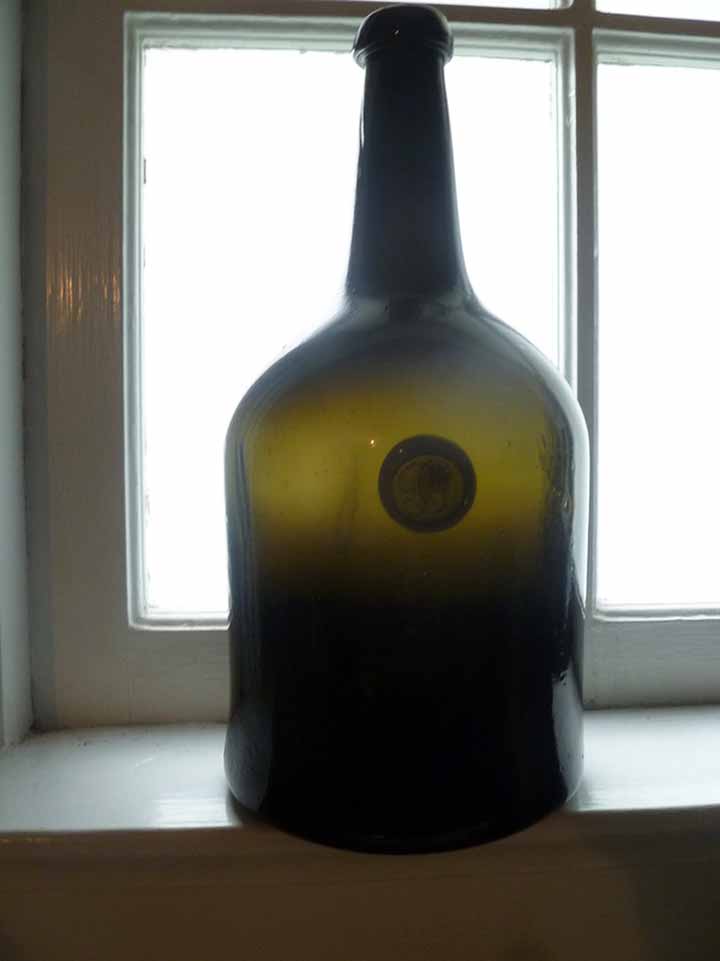
Gary Katzen’s, 14 inch tall, personalized with the letters “P S”, German type, rolled lip, seen often on glass attributed to Wistarburgh. Deep olive amber in color – Katzen Collection
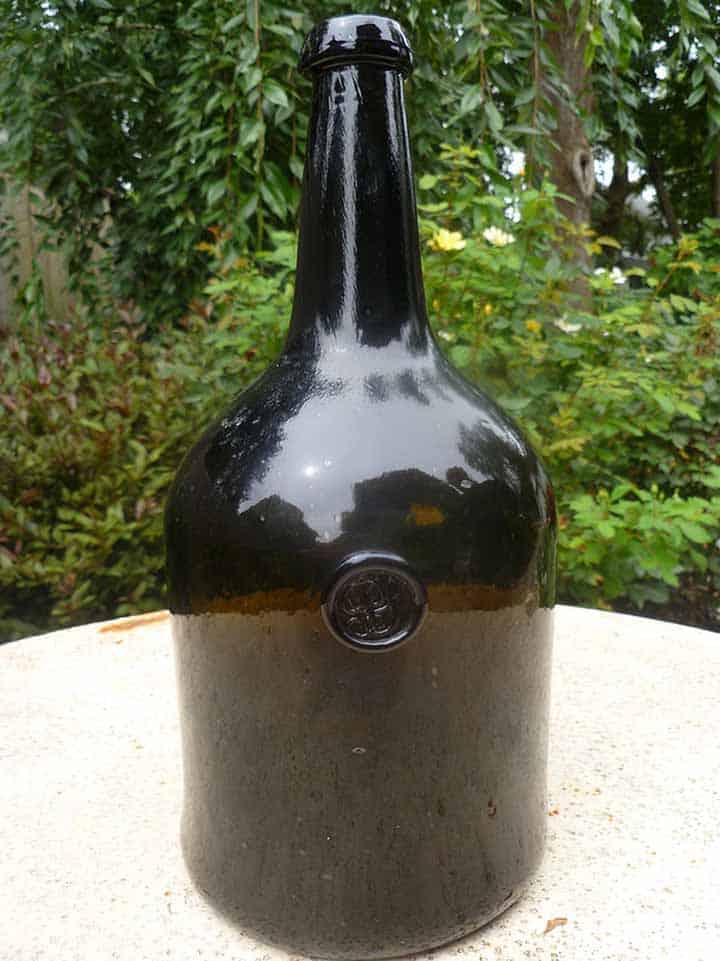
Photographed outside on a stone top table. This bottle is as black as night in broad day light. The color looks like dark amber but it is black glass in the true sense when photographed outside – Katzen Collection
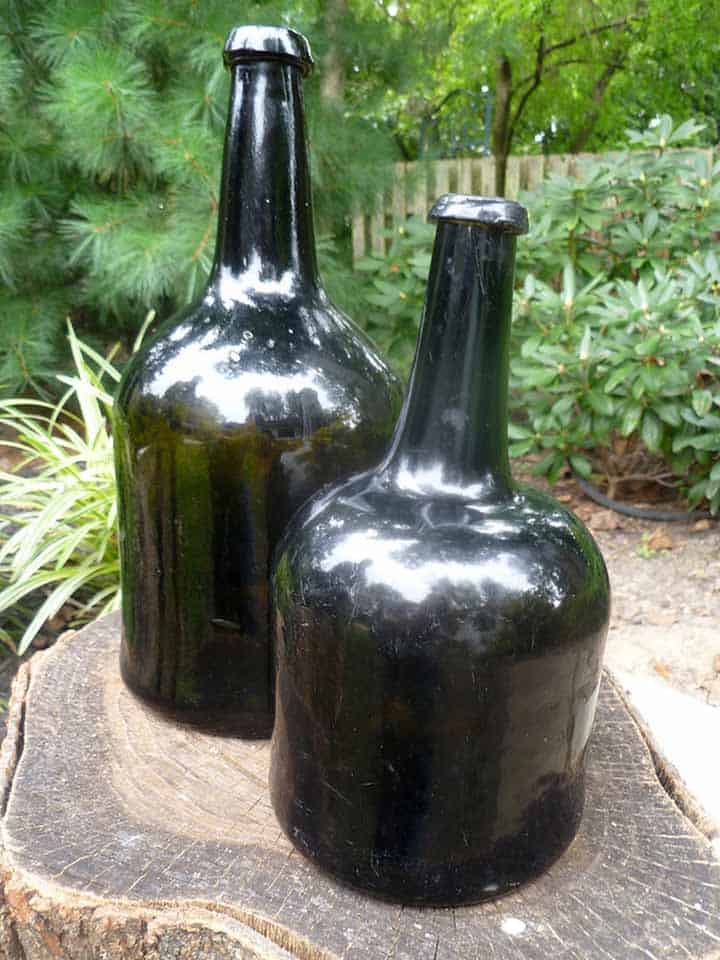
Photographed with a Wistarburgh attributed mallet type wine bottle. This bottle is a huge wine bottle as the Wistarburgh bottle stands 9 and a half inches tall. Both bottles are extremely dark in color.
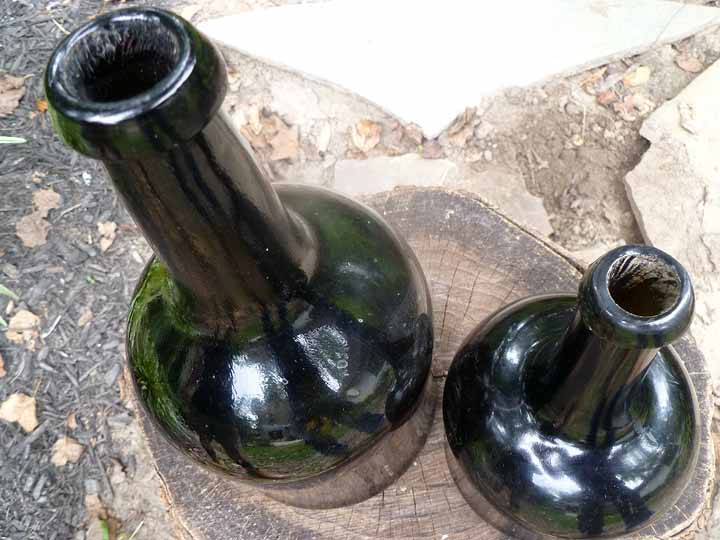
Looking down into each bottle, you can see similar markings on the inside of each lip. The bottle sports the famous Wistar rolled lip, suggesting a gaffer from the same region Caspar and his son Richard imported their workers from.
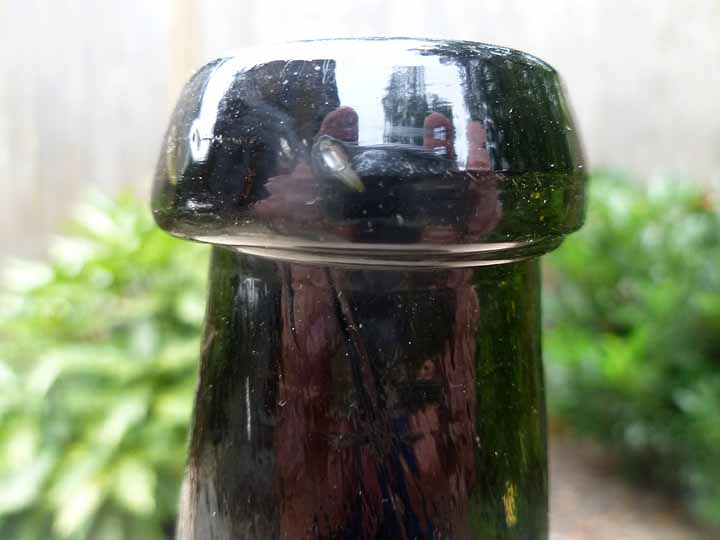
In close on the rolled lip, Gary suggested umbrellas and sheets and…I told him it would cost us a fortune to have these bottles professionally photographed!! This is good enough!!
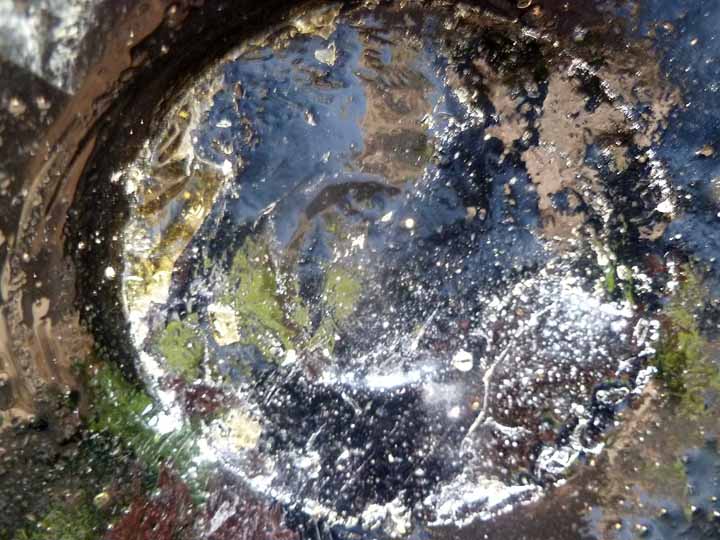
I have named this picture the world map pontil mark for I can see Africa and Asia like shapes in the areas within the sand pontil mark.
About Stephen Atkinson
Stephen Atkinson, from Sewell, New Jersey has been collecting bottles and glass since he was 12 years old. He once dug an original EG Booz figural cabin bottle on Norris Street in Mantua, New Jersey in 1972 at 12 years old and traded it for six bitters bottles. Fast forward to 2012 and Stephen bought the exact bottle back at an estate auction in New Jersey!
His passion is for pre-1880 glass, as the majority of his collection consists of historical flasks, colonial era chestnut bottles, and whimsical end of day pieces of glass. He also has three rare T.W. Dyott bottles, an original Dr. Robertson’s family medicine; one of the rarest collectable American bottles, a T.W. Dyott vial bottle dug by Chris Rowell and a paper labeled T.W. Dyott bottle. He has researched many southern New Jersey glass works first hand by locating the original factory sites. The best piece in his collection is the Wistarburgh Glass Company ledger showing monies paid out to Caspar Wistar’s Children and their husbands and wives.
Read more in this series by Stephen Atkinson:
The New York State Glass Factories | Preface to a Series
Newburgh (Glass House Co.) 1751-1759 | Part 1
Glass House Farm (Glass House Co) 1758-1772 | Part 3
Posted in Article Publications, Black Glass, Blown Glass, Collectors & Collections, Early American Glass, Glass Companies & Works, Glass Makers, Holiday, Questions
Tagged Black, Brooklyn, English, Frederick Hunter, Fredrick Van Cortlandt, Gary Katzen, Glass, Glass House Company, Johan Martin Greiner, Lodewyk Bampers, New Netherland, New York, Peter Stuyvesant, Petrus Stuyvesant, seal, Sidney Breese, Stephen Atkinson, Van Cortlandt Museum, Wistarburgh
Leave a comment
Heckler Auction 105 – Looking at Paint on Bottles
Heckler Auction 105 – Looking at Paint on Bottles
From the late Carl Sturm Collection
09 September 2013
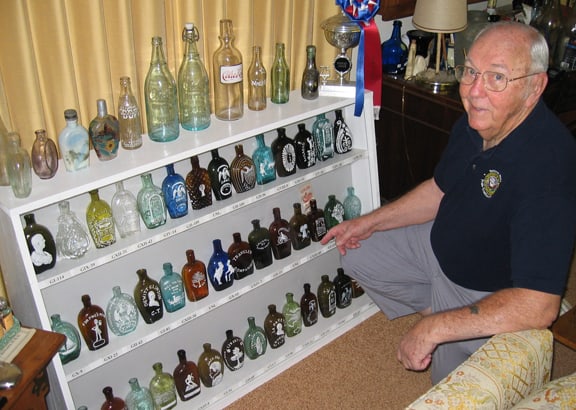
![]() The folks at Heckler have another outstanding auction that closes this Wednesday evening. This is one of their ‘Opportunity’ auctions meaning it is not a ‘full fledged higher dollar catalog event’. The bottles and presentation photography are extraordinary as usual.
The folks at Heckler have another outstanding auction that closes this Wednesday evening. This is one of their ‘Opportunity’ auctions meaning it is not a ‘full fledged higher dollar catalog event’. The bottles and presentation photography are extraordinary as usual.
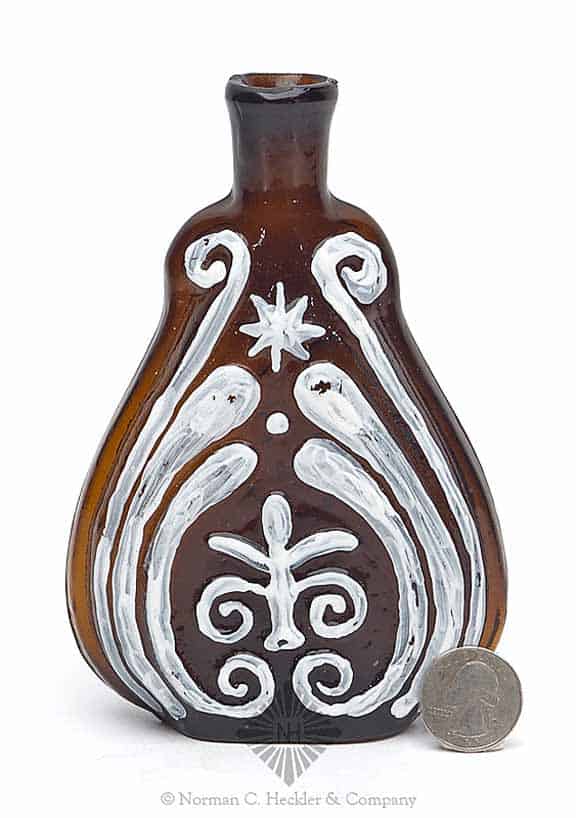
Lot: 126 Scroll Flask, probably Louisville Glass Works, Louisville, Kentucky, 1845-1860. Deep root beer amber with a puce tone, sheared mouth – pontil scar, half pint; (light high point wear). GIX-34 A beautiful flask. Fine condition. Carl Sturm collection. – Heckler Auction 105
What I wanted to look at here were a few of the ‘painted’ bottles from the late Carl Sturm collection. Carl was an extraordinary man, with an extraordinary collection who obviously preferred paint on his bottles. I suspect we will see more of Carl’s collection in upcoming Heckler auctions. Many of you do not like paint on bottles as I monitor the conversations on facebook etc. Some collectors apply the ‘removable paint’ for presentation and readability. My father liked painted typography on bottles even though I didn’t and I told him. It did not matter. When I was at the legendary John Feldmann’s house looking at his great bottle collection, many of the ‘secondary’ bottles were in an adjacent room without display windows, contrary to his killer window room. The bottles were primarily amber bitters squares and painted with white graphics. Neither John, nor any viewer like myself could have ever read or understood what each bottle was because the lighting was dim and there was wood behind the bottles. The paint made it work. To each his own. Many of the older collectors prefer and preferred this method. I even have a few bottles with painted graphics. It is interesting, when I put the painted bottles in windows, you really cannot see the paint. Of course, I can always remove the paint. Just don’t use sandpaper! Here are a few of Carl’s bottles in the Heckler auction. Let’s look at these with respect. As someone said on Facebook, “That is why there is Vanilla and Chocolate”.
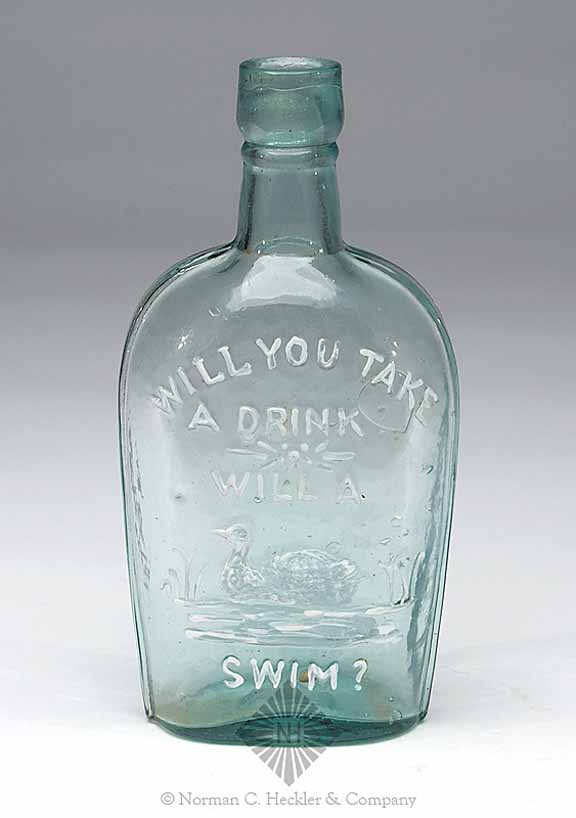
Lot: 6 “Will You Take / A Drink / Will A / (Duck) / Swim?” Pictorial Flask, probably Lockport Glass Works, Lockport, New York, 1870-1880. Aquamarine, tooled sloping collared mouth with ring – smooth base, half pint. GXIII-29a Strong embossing. Fine condition. Carl Sturm collection. – Heckler Auction 105
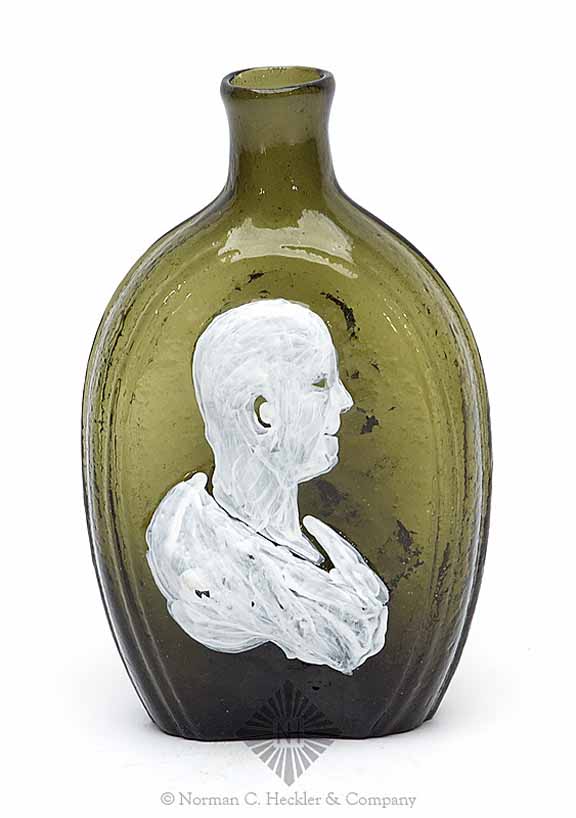
Lot: 175 Byron – Scott Portrait Flask, a Stoddard glasshouse, Stoddard, New Hampshire, 1840-1860. Yellowish olive, sheared mouth – pontil scar, half pint; (light high point wear). GI-114 Great color. Fine condition. Carl Sturm collection. – Heckler Auction 105
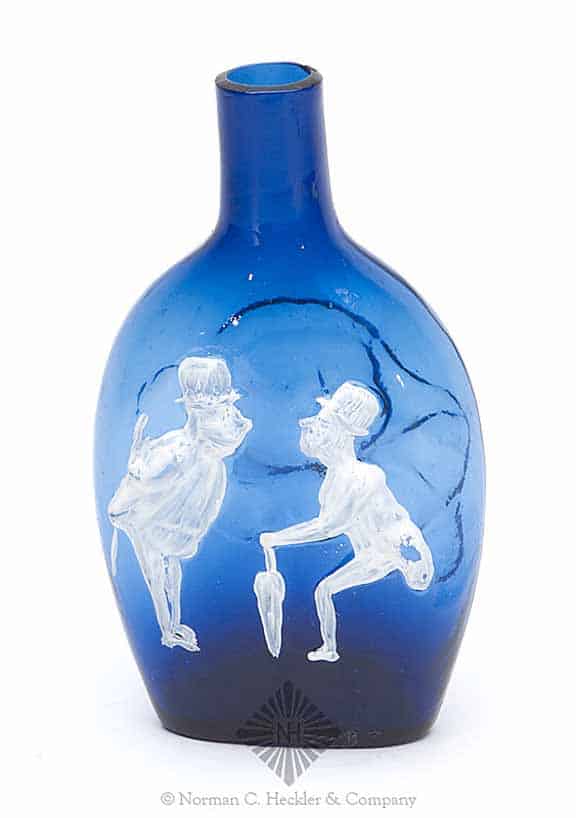
Lot: 19 Two Men Arguing – Grotesque Man’s Head Pictorial Flask, Europe, 1830-1860. Brilliant cobalt blue, sheared mouth – pontil scar, half pint; (minor exterior high point wear). GX-12 Brilliant, beautiful color. Fine condition. Carl Sturm collection. – Heckler Auction 105
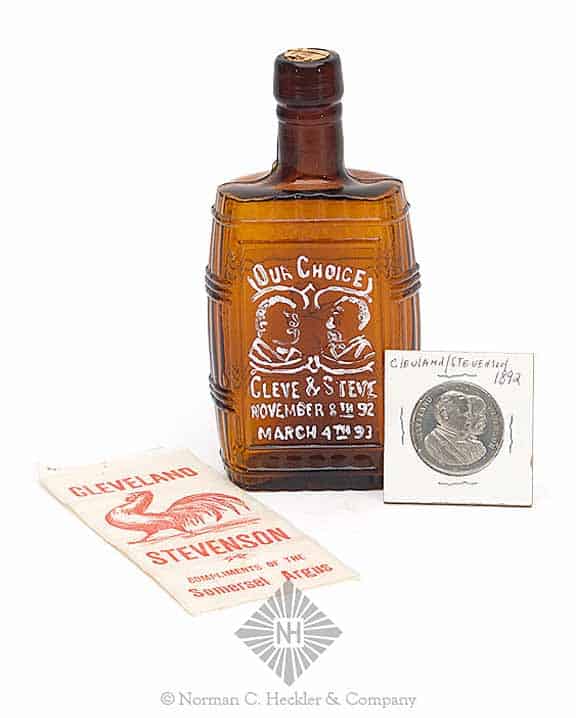
Lot: 37 “Our Choice / Cleve & Steve / November 8th 92 / March 4th 93” And Busts – Rooster Portrait Flask, America, 1892-1893. Medium golden amber, tooled sloping collared mouth with ring – smooth base, half pint. GI-124 Strong mold impression. Fine condition. This flask is accompanied by a related souvenir advertising coin and banner. Carl Sturm collection. – Heckler Auction 105
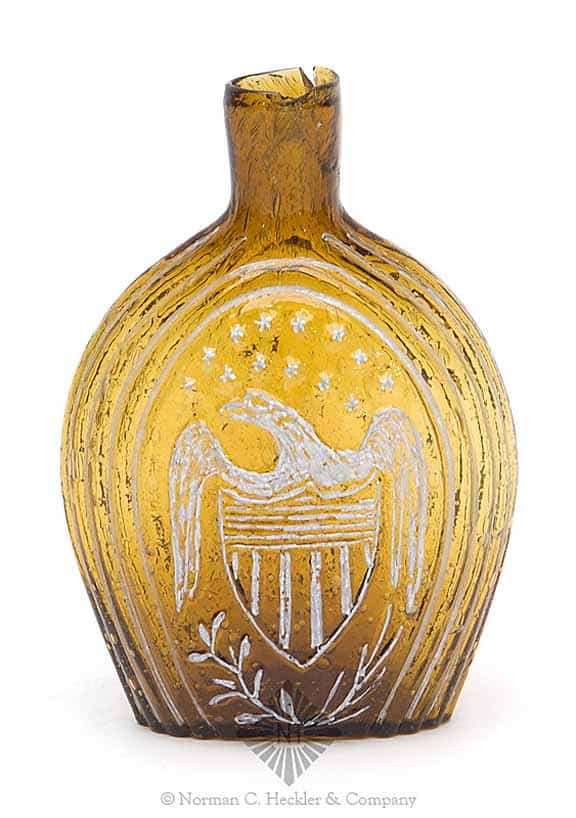
Lot: 47 Eagle – Grapes Historical Flask, Coffin and Hay Manufactory, Hammonton, New Jersey, 1836-1847. Brilliant golden amber, sheared mouth – pontil scar, half pint; (1 inch by 1 inch piece has been broken away and reglued to mouth). GII-56 Outstanding rare color. Numerous bubbles. Carl Sturm collection. – Heckler Auction 105
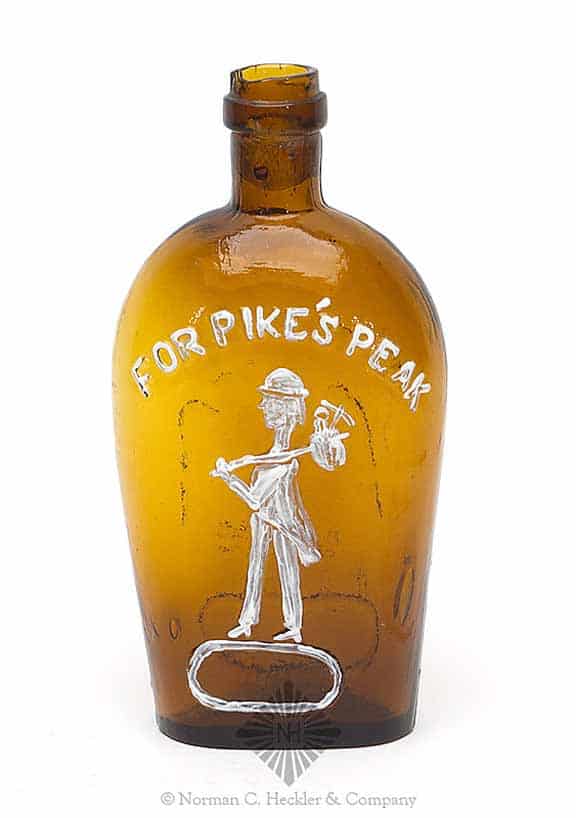
Lot: 56 “For Pike’s Peak” And Prospector – Eagle Historical Flask, America, 1860-1870. Medium yellowish amber, applied square collared mouth – smooth base, half pint; (1/2 inch bruise and crack on mouth, multiple 1 inch hairline fissures near base). GXI-23 Strong mold impression. Carl Sturm collection. – Heckler Auction 105
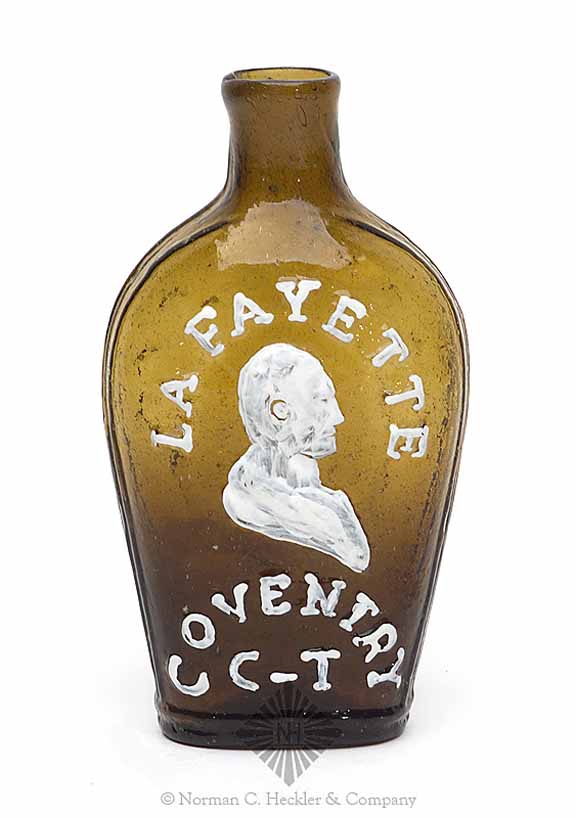
Lot: 105 “Lafayette” And Bust – Liberty Cap Portrait Flask, Coventry Glass Works, Coventry, Connecticut, 1824-1825. Bright yellow olive, sheared mouth – pontil scar, half pint; (minor high point wear, 1/8 inch bruise in shoulder). GI-86 Beautiful color. Carl Sturm collection. – Heckler Auction 105
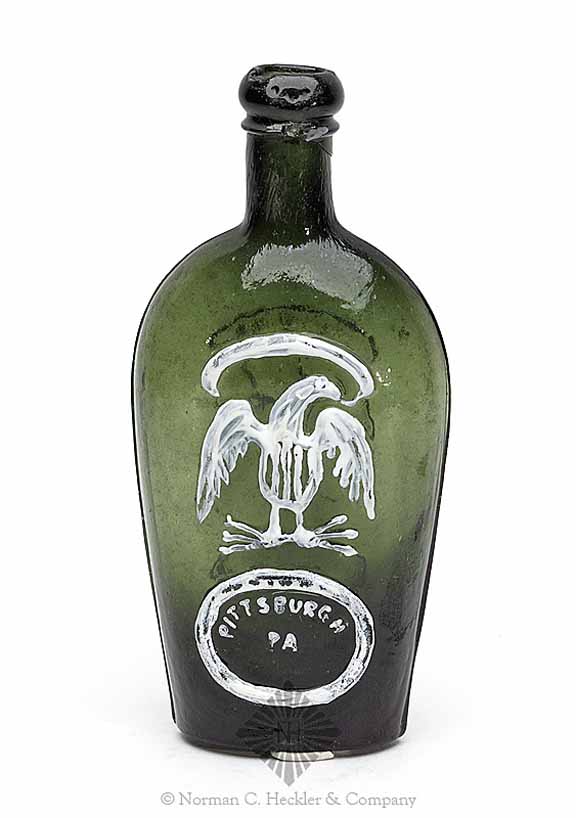
Lot: 107 Eagle And “Pittsburgh / PA” – Eagle Historical Flask, Pittsburgh district, Pittsburgh, Pennsylvania, 1860-1870. Medium greyish olive green, applied double collared mouth – smooth base, half pint; (1/8 inch by 3/8 inch chip from lower mouth ring, overall wear). GII-109 Good color. Carl Sturm collection. – Heckler Auction 105
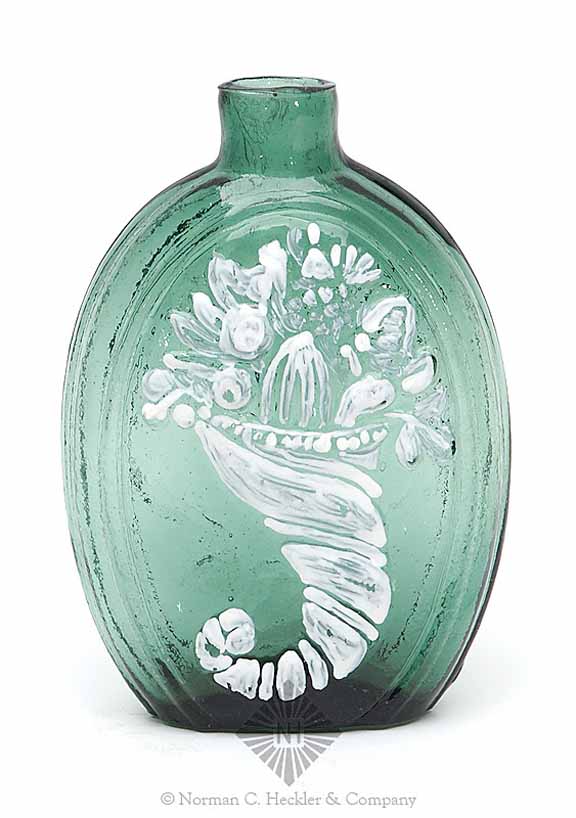
Lot: 129 Cornucopia – Urn Pictorial Flask, Keene Marlboro Street Glassworks, Keene, New Hampshire, 1820-1840. Medium blue green, sheared mouth – pontil scar, half pint; (minor high point wear). GIII-7 Pretty color. Good mold impression. Carl Sturm collection. – Heckler Auction 105
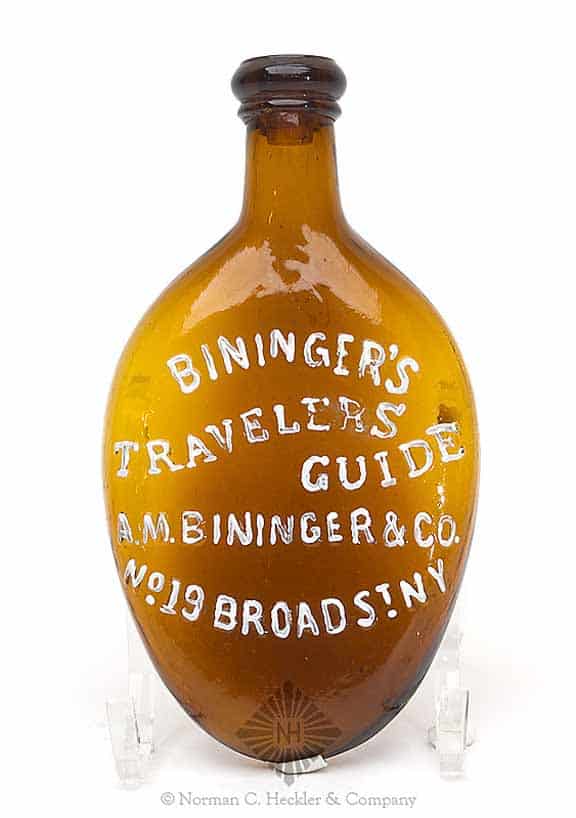
Lot: 142 “Bininger’s / Travelers / Guide / A.M.Bininger & Co. / No. 19 Broad St. N.Y.” Pocket Flask, America, 1860-1870. Bright yellow amber, applied double collared mouth – smooth base, half pint. Beautiful lighter color. Fine condition. Carl Sturm collection. – Heckler Auction 105
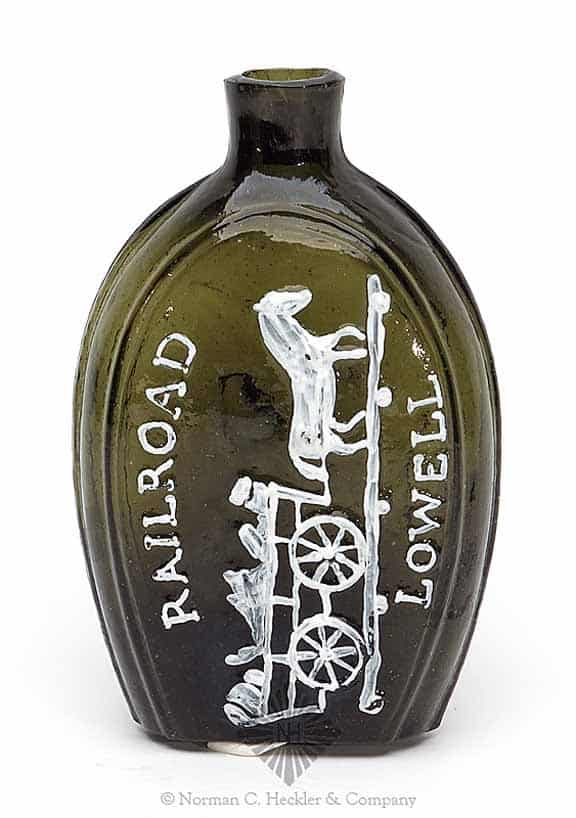
Lot: 229 “Lowell / Railroad” And Horse And Cart – Eagle Historical Flask, Coventry Glass Works, Coventry, Connecticut, 1820-1840. Brilliant yellow olive, sheared mouth – pontil scar, half pint; (shallow 1/8 inch by 1/4 inch flake off mouth, 1/8 inch mouth bruise). GV-10 Pretty color. Carl Sturm collection. – Heckler Auction 105
Posted in Advice, Auction News, Collectors & Collections, Flasks, Historical Flasks, News, Questions
Tagged Carl Sturm, Flask, Heckler, paint, Scroll
Leave a comment
Check these T. W. Dyott bottles out!
Check these T. W. Dyott bottles out!
09 September 2013
![]() It has really been just fantastic lately to see researchers, collectors and writers submit information for posting on Peachridge Glass. The last exchanges with Stephen Atkinson have been perfect examples. Read: Henry Bolingers Maysville Glass-Works 1814-1825 and The New York State Glass Factories. In this case, Steve sent me an e-mail with some rather interesting information and imagery to share.
It has really been just fantastic lately to see researchers, collectors and writers submit information for posting on Peachridge Glass. The last exchanges with Stephen Atkinson have been perfect examples. Read: Henry Bolingers Maysville Glass-Works 1814-1825 and The New York State Glass Factories. In this case, Steve sent me an e-mail with some rather interesting information and imagery to share.
Ferdinand:
Check these T. W. Dyott bottles out! The Robertson’s and the small vial have had lip repairs but are about the rarest of all the collectable medicines. The vial has never been recorded (not one example!!) and the Dr. Robertson’s Family Medicine may have had ten examples show up in 80 years of glass collecting as attested to by Helen McKearin. Chris Rowell dug the Dyott vial in a deep privy in Philadelphia. The Robertson bottle was dug by Christian Raezer in Lancaster County, Pennsylvania. The paper labeled one, again never before seen. I acquired it in a trade for a damaged EG Booz bottle. I think the Dyott’s and the Lee medicine bottles out of Baltimore and New York City are about the rarest of all the collectable medicines. I have a huge write-up planned on Dyott and the Kennsington glass factory he owned. I will send you the finished pages in the next two weeks.
Dr. ROBERTSONS FAMILY MEDICINE
SOLD ONLY BY T W DYOTT
TW DYOTT embossed on a small vial type bottle
Paper labeled, square flint glass bottle labled T W DYOTT
I was at Dyottville while it was exposed during the archeological dig in the winter of 2011 and was invited to the site. This was the archy’s attempt at showing the public their work. When I inquired about getting a few bricks from the site they said I needed permission from Penn DOT (well, we know how that would have gone). They didn’t even offer Corning, Wheaton, Winterthur, or even the Smithsonian, all who had representatives at the site the same day I was there, anything from the site. All finds,which were immense, were going to the Penns Landing Museum and believe me, it wasn’t much of a display. A small 10 x 10 area, as most was just being stored. I have called Corning and Wheaton and neither entity ever received anything from the dig.
Dyott owned the factory in 1820 to 1840 but It was founded much earlier in 1770. The bricks that were recovered are from the oldest part of the factory in which I sent you pictures.
The photos I sent you are the following items:
The rectangular shaped bottle Embossed with Dr. ROBERTSONS FAMILY MEDICINE SOLD ONLY BY T W DYOTT. The name TW DYOTT embossed on a small vial type bottle and a paper labeled, square flint glass bottle labled T W DYOTT. The bricks from the site and the exposed foundations of the ovens and the factory walls at Dyottville are the other pictures. Enjoy.
Thanks again – Steve
The bricks from the site and the exposed foundations of the ovens and the factory walls at Dyottville
Read more on Peachridge Glass on Dyott:
Thomas W. Dyott Portraits…painted, printed and embossed
Singing along at Dyottville Glass Works
A lot of Collectors find Dyottville fascinating
Civil War era Dyottville Embossed Cylinder Bottles
Posted in Blown Glass, Collectors & Collections, Digging and Finding, Early American Glass, Glass Companies & Works, Glass Makers, History, Medicines & Cures
Tagged brick, Chris Rowell, Christian Raezer, Dr. Robertson, Dyottville, Flint, Glass, Helen McKearin, oven, Steve Atkinson, T.W. Dyott, vial
Leave a comment
Beer Street and Gin Lane by William Hogarth
Beer Street and Gin Lane
William Hogarth
08 September 2013
Beer Street and Gin Lane are two prints issued in 1751 by English artist William Hogarth in support of what would become the Gin Act.
they depict the evils of the consumption of gin as a contrast to the merits of drinking beer
Designed to be viewed alongside each other, they depict the evils of the consumption of gin as a contrast to the merits of drinking beer. At almost the same time and on the same subject, Hogarth’s friend Henry Fielding published An Inquiry into the Late Increase in Robbers. Issued together with The Four Stages of Cruelty, the prints continued a movement started in Industry and Idleness, away from depicting the laughable foibles of fashionable society (as he had done with Marriage à-la-mode) and towards a more cutting satire on the problems of poverty and crime.
On the simplest level, Hogarth portrays the inhabitants of Beer Street as happy and healthy, nourished by the native English ale, and those who live in Gin Lane as destroyed by their addiction to the foreign spirit of gin; but, as with so many of Hogarth’s works, closer inspection uncovers other targets of his satire, and reveals that the poverty of Gin Lane and the prosperity of Beer Street are more intimately connected than they at first appear. Gin Lane shows shocking scenes of infanticide, starvation, madness, decay and suicide, while Beer Street depicts industry, health, bonhomie and thriving commerce, but there are contrasts and subtle details that some critics believe allude to the prosperity of Beer Street as the cause of the misery found in Gin Lane. [Wikipedia]
Listen to NPR: ‘The Book Of Gin’ Distills A Spirited History
BEER STREET
Beer Street depicts industry, health, bonhomie and thriving commerce.
GIN LANE
Gin Lane shows shocking scenes of infanticide, starvation, madness, decay and suicide.
Posted in Advice, Ales & Ciders, Art & Architecture, Breweriana, Gin, History, Spirits
Tagged Beer, Gin, William Hogarth
Leave a comment

